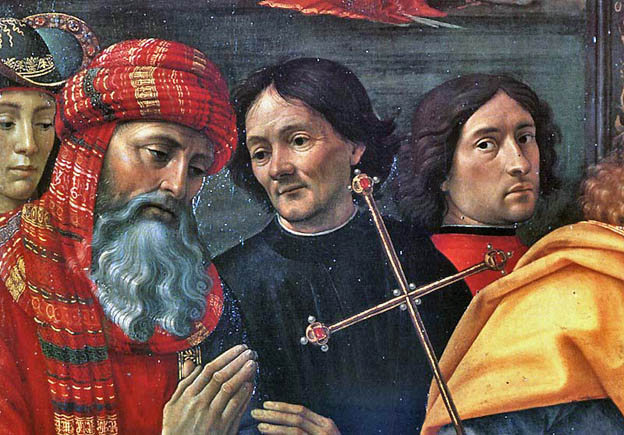
1449 - 1494

Self-Portrait, from Adoration of the Magi: 1488
(Domenico Ghirlandaio is on the far right.)
Early works (1471-73)
Ghirlandaio began work in country churches in the immediate vicinity of Florence, at Cercina and Brozzi, his guardians were the Vespucci, the most important family in his neighborhood, whose most illustrious member was Amerigo Vespucci, the great explorer. This family commissioned Ghirlandaio in 1471 to decorate their mortuary chapel in the church of Ognissanti in Florence. He devoted himself fully to painting in San Gimignano.
Apse Fresco: ca 1471
Parish Church of Sant'Andrea, Cercina

Ghirlandaio's earliest surviving work can be found in a parish church close to Florence. In 1471, he painted a fresco in a side apse of the small parish church of Sant'Andrea in the town of Cercina. Within the small space of the apse he created an illusory architectural setting consisting of three niches separated by Corinthian pilasters. In the centre niche Saint Barbara is standing on the body of her father, who has been struck down by lightning. On either side of her are Saints Jerome and Anthony. Everything is arranged to highlight the female saint. The gentle colors in which she is depicted, purple and a light, almost violet red, harmonize her with the golden orange of the capitals and upper part of the apse. The large square under her niche is also painted in a reddish brown imitation marble to emphasize the central axis, while the squares on either side correspond to the muted colors of the two hermits.
In this fresco, the young Ghirlandaio was playing with illusionistic techniques in order to prove what he and his art were capable of. The shadows cast by the figures suggest they are standing freely in the niches; the figures are not rigid, and their movements and their physical presence expands the space they seem to occupy. Here painting is becoming three-dimensional, the figures free to move.
Saint Anthony is marking the outer border of his niche with his staff and is not venturing across it. In contrast, Saint Jerome, cautiously taking a step forward, is feeling his way onto the painted cornice with his bare toes. In this detail the artist is not only creating a spatial effect, he is also adding a tactile element that is reminiscent of Flemish painting - in Jan van Eyck's Ghent Altarpiece, painted in 1432, Adam and Eve are taking a step forward in their niches. There is, however, a more immediate model for Saint Jerome's posture and physical stature: a fresco by Domenico Veneziano, painted after 1455, in the Florentine monastery of Santa Croce, in which Saint John the Baptist is depicted in a similar manner.
The hands of Saint Barbara's father, who has been struck down for having his daughter killed because of her Christian beliefs, are casting shadows on the cornice underneath. The hands appear to be projecting right out of the niche into real space, an impression that raises the question of whether these figures are painted or sculpted. Such illusionistic methods of depiction lead us to assume that there was competition between the arts. A few years later, Andrea del Verrocchio extended the "play" between the internal and external in sculpture on the façade of the shrine of Orsanmichele in Florence, by placing the figure of Doubting Thomas at very front of the niche in which Christ stands.
Saint Barbara: ca 1471
Parish Church of Sant'Andrea, Cercina

The vivid color of her garments and the different shape of her niche give greater emphasis to the figure of Saint Barbara, who stands between the two old men, Saint Jerome and Saint Antony. She is holding her attribute, a tower, and in contrast to the two other saints is looking directly to us.
Because she was so beautiful, Barbara's pagan father locked her in a tower. She converted to Christianity, and against his wishes built in her tower a chapel, its three windows symbolizing of the Trinity. Enraged, her father had her beheaded. Here she is depicted standing triumphantly on the armor-clad corpse of her father, who has been killed by a bolt of lightning. His hands are hanging down over the cornice, where they are casting illusory shadows.
Saint Jerome: ca 1471
Parish Church of Sant'Andrea, Cercina
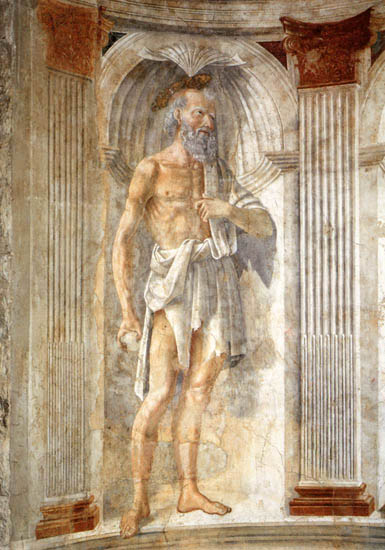
Saint Jerome, wearing a torn penitential robe, is looking across at Saint Barbara. His wiry, semi-naked body seems to have been ravaged by the hardships of his hermit life. In his right hand he is holding a stone with which to beat himself. His stance is reminiscent of classical contrapposto, his right foot protruding out of the space of the niche across the painted cornice.
Saint Antony: ca 1471
Parish Church of Sant'Andrea, Cercina
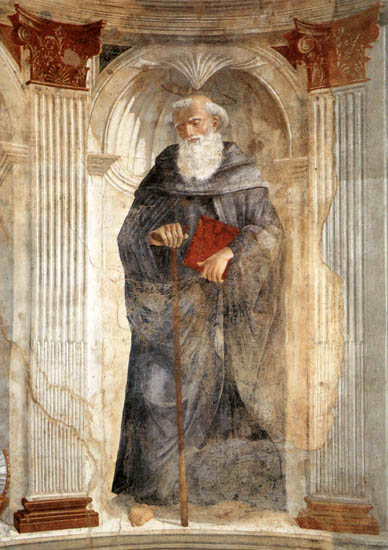
In contrast to his counterpart, Saint Jerome, Saint Antony is dressed in a dark monk's habit. He is looking downwards at the figure on which Saint Barbara is standing. The attributes he is carrying are a book and the T-shaped staff on which he is leaning.
Madonna of Mercy and Lamentation: ca 1472
Ognissanti, Florence
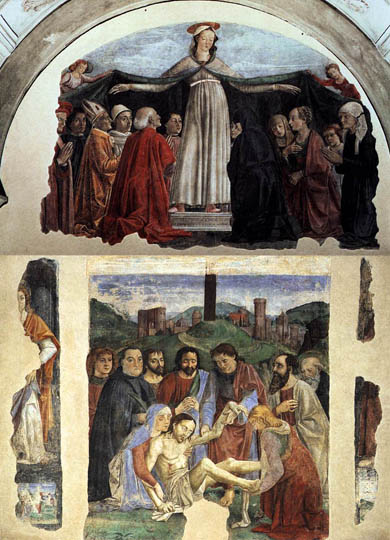
An influential Florentine artist during the hegemony of Lorenzo il Magnifico, Domenico Ghirlandaio had the most active painter's workshop in the city. In this early fresco of the Deposition with the Madonna of the Misericordia, Domenico had not yet achieved his unmistakable personal style.
Madonna of Mercy: ca 1472
Ognissanti, Florence
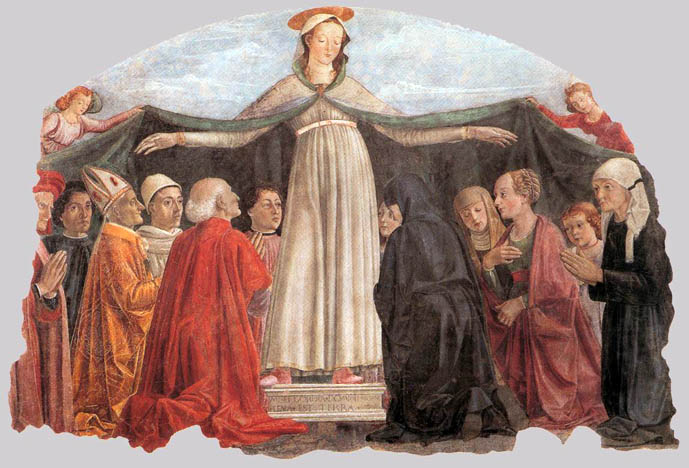
"His first paintings were in the Chapel of the Vespucci at Ognissanti, representing a dead Christ and some saints, and a Misericordia over an arch, containing a portrait of Amerigo Vespucci, who navigated the Indies..." (Vasari).
The date of the chapel's construction is 1472. We can date the frescoes immediately afterward. In these Ognissanti frescoes the inspiration of Baldovinetti is marginal; more obvious are certain elements acquired from Andrea del Castagno and some clear, vivid colors that are reminiscent of Domenico Veneziano. Most interesting, however, is the artistic personality of Ghirlandaio himself, so well defined at this early age, and that attentive observation of man in every physical and interior detail that made him such an able portraitist.
Here is the old man, probably the head of the family, seen from behind, kneeling, solidly built, his lean face with its hard features softened by the whiteness of his fine hair. The older woman in a cloak stands out in a contrast of lights and colors. Serenely clear, on the other hand, is the younger woman, with her hair gathered into plaits and her ample forehead shaved back according to the Florentine fashion of the time. The expression on the face of the boy, thought to be Amerigo Vespucci, is intense; his face, with its full lips and large clear eyes, is still chubby, pinkish and childlike. Domenico's attention seems to have lingered on the figures, perhaps in prayer, right there in Ognissanti, his brush faithfully reproducing and individualizing the features of each of them.
Lamentation over the Dead Christ: ca 1472
Ognissanti, Florence
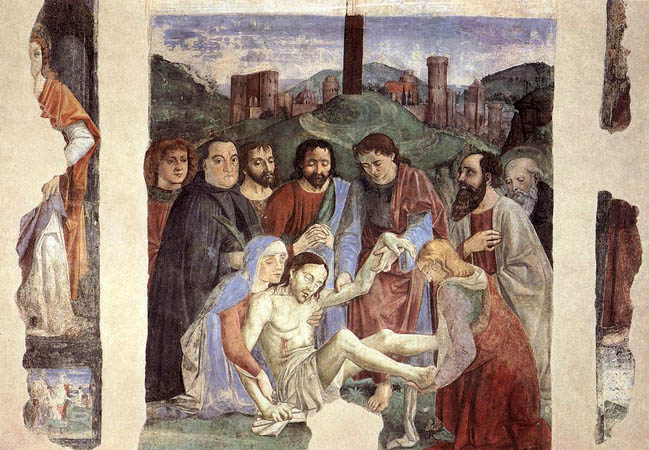
Marked by the signs of grief, Mary is embracing her dead son. Mary Magdalene and Saint John are holding Christ's arms and legs, his hands and feet marked with the stigmata. Around the group are six other saints, including, on the right, Joseph of Arimathea and Nicodemus. Behind them, on the Hill of Golgotha, the trunk of the Cross is towering up in front of a view of the city of Jerusalem.
Madonna and Child with Saint Sebastian and Saint Julian: ca 1473
Sant'Andrea a Brozzi, San Donnino

About 1473, Ghirlandaio painted the fresco Madonna and Child with Saints Sebastian and Julian in the church of Sant'Andrea a Brozzi in San Donnino near Florence. It is still disputed whether Ghirlandaio carried out this work, which is in a regrettably poor state of preservation, before or after his work in San Gimignano in about 1475. It is clear that in this Madonna and Child he does not appear to have found his own style yet.
When compared to Ghirlandaio's later versions of this theme, the composition appears to have been constructed rather summarily. The figures seem simply to have been lined up, as if placed on pedestals in niches, a feature that brings to mind the apse fresco in Cercina. In Sant'Andrea a Brozzi, however, the architecture - with the exception of the seashell-shaped niche above the throne and the framing pilasters - has been minimized in favor of a landscape. The saints are no longer standing in niches, but posing on a terrace high above a river. The strictly arranged figures do not overlap in any way and are standing in front of a poorly developed space. In his later use of such themes, Ghirlandaio would attempt to fill every empty space in the picture.
The type of Madonna depicted and the form of the standing Christ Child are clearly influenced by Verrocchio, and it is likely that Ghirlandaio spent some time working in his workshop.
The high forehead, sharp chin and narrow lips of Mary, and the upright contrapposto pose of her sturdy child are the features most clearly reminiscent of figures by Verrocchio. The Christ Child, shown naked, is seen from a frontal view standing on a small cushion lying on his mother's right thigh. This motif also was borrowed from Verrocchio and is used by Ghirlandaio on a further occasion in about 1479, on the altarpiece in Lucca, where he makes only slight changes to the child's stance. In both works, the figure of Mary with the high waistline belongs to the same type. Her garment, which has been totally destroyed above the knees in the fresco, can be reconstructed using the one shown in the later panel painting.
Because of the fresco's poor state of preservation, there is little that can be said about the effect of the colors and modeling of the garments. The artistic qualities of this work have been largely destroyed, though this is not a reason for dismissing the fresco too readily.
The two saints on either side of the throne are wearing fashionable clothing and posing rather affectedly. Both figures are derived from models in Castagno's Assumption of the Virgin dating from about 1450 and now in the Berlin Gemäldegalerie. This type of young man will frequently appear in Ghirlandaio's later works. Saint Sebastian on the left is turning to the Christ Child with an affectedly elegant gesture, and Saint Julian is holding out his sword. As he does so, he casually places his left hand on his hip. The same posture is rather amusing when seen in the Lucca Christ Child, as it is so unusual for a small child. The relationship of the motifs in the panel painting in Lucca and the fresco in Sant'Andrea can also be seen in the posture of the gray figure of Saint Paul, who is holding his sword in the same manner as Saint Julian. The Saint Sebastian in the panel painting has a similarly angelic face to the one in the fresco. In addition, both figures are holding arrows, the symbols of their martyrdom, with their fingertips.
Baptism of Christ: ca 1473
Sant'Andrea a Brozzi, San Donnino
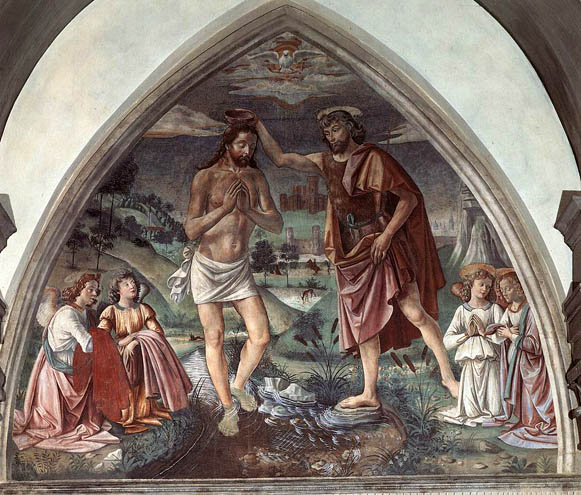
The fresco is in the tympanum above the Madonna and Child with Saints. Two angels are kneeling on the left bank of the river Jordan, shown as a little flat stream flowing towards us. They are holding the clothes of the person being baptized, who is clad only in a loincloth. Christ is standing in water up to his ankles. St John the Baptist, in a fur robe, is gathering up his cloak and stepping carefully on to a stone to baptize Christ.
This fresco, because of its poorer quality, is frequently attributed to assistants from Ghirlandaio's workshop. It is a loose copy of the famous panel painting which Verrocchio painted with the help of his assistant Leonardo da Vinci. Ghirlandaio added the two praying angels on the right of his composition, and these, together with the corresponding figures on the other side of the river, form a compositional frame for the work. This assumption that clear symmetrical balance is important shows that the artist was still rather conservative.
Saint Barbara Crushing her Infidel Father, with a Kneeling Donor: ca 1473
Private Collection

This painting is probably the earliest panel painting by Ghirlandaio. There is a close formal connection between this panel and Ghirlandaio's frescoed St Barbara in the church of Sant'Andrea, Cercina, which is considered by most recent scholars to be among his earliest extant works.
The Stories of Saint Fina at San Gimignano (1473-75)
Violets flower in March in San Gimignano, a town of many towers; they are celebrated as the "Fiori di Santa Fina", the flowers of Saint Fina, the town's patron saint. Fina, the pious daughter of poor parents, died on the feast day of Saint Gregory in 1253 after a long and painful illness. She was just fifteen years old. According to legend, after the death of her mother Fina lived an ascetic lifestyle so strict she was, in the end, scarcely able to move. At the instant she died, white, beautifully scented flowers blossomed forth from her bed of pain.
Between 1468 and 1472, architect Giuliano da Maiano built Saint Fina's mortuary chapel in the collegiate church (his brother Benedetto da Maiano created the saint's burial altar about 1475) and Ghirlandaio covered the walls with frescoes. Both artists were working in direct competition with each other, for they were depicting the Obsequies of Saint Fina side by side, each using his own medium, fresco and relief carving. The entire layout of the magnificent ensemble, which is still in its original location, is reminiscent of Antonio Rossellino's mortuary chapel for the Portuguese cardinal dating from 1461-66 in the Florentine church of San Miniato al Monte, the frescoes for which were painted by Ghirlandaio's first teacher, Alessio Baldovinetti.
The year in which the frescoes in the chapel of Saint Fina were executed can be fixed almost with certainty at 1475 or shortly after. There are two Stories of Saint Fina: the Apparition to Fina of Saint Gregory who announces her Death and the Obsequies of the Saint.
It was in the frescoes for this chapel Ghirlandaio was able to develop his own style. The two frescoes in the Saint Fina Chapel are the first major works of Ghirlandaio's career. There are already signs of the architecture that will feature in his later works, here imaginatively and skillfully constructed according to the laws of perspective. The spaces appear to be filled with light and air and to create a bright atmosphere that is enhanced by the luminous colors of Domenico Veneziano. Also evident here is Ghirlandaio's ability, which was much appreciated by his patrons, of including them and their families in religious scenes.
Announcement of Death to Saint Fina: 1473-75
Colleggiata, San Gimignano
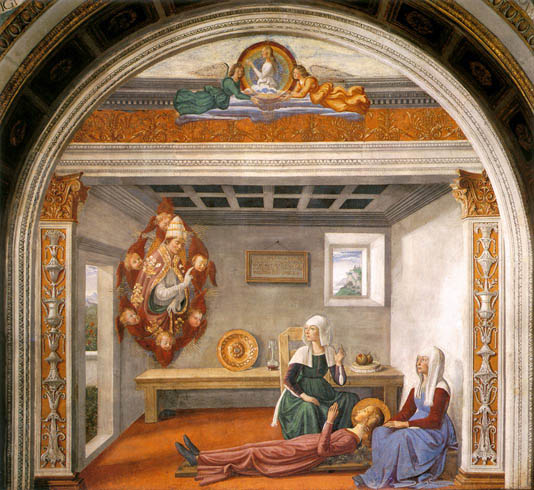
Fina, the pious daughter of poor parents, died on the feast day of Saint Gregory in 1253 after a long and painful illness. She was just fifteen years old. According to legend, after the death of her mother Fina lived an ascetic lifestyle so strict she was, in the end, scarcely able to move. Vermin and rats gnawed at her body until death finally liberated her from her prolonged sufferings. Pope Gregory the Great, in full regalia, appears floating in a glory of red winged angels to bless the young woman and announces her imminent death. At the instant she died, white, beautifully scented flowers blossomed forth from her bed of pain. The witnesses to this miracle are her old nurse and another woman, possibly a helpful neighbor.
The neighbor greets the great Church Doctor hesitantly with a gesture of restrained fright. Behind her is a row of objects on a bench. One of the items leaning against the rear wall of the box-shaped room is a golden bowl, an object that seems out of place in this bleak scene. The same is true of the pilasters on either side, whose golden capitals support the huge architrave. This architecture is designed to create an opulent frame for the picture rather than to reflect the place where the events are unfolding.
Announcement of Death to Saint Fina (Detail): 1473-75
Colleggiata, San Gimignano
_1473_75.jpg)
Next to the shining bowl is an almost empty decanter, covered by an inverted glass to protect the valuable wine. As the artist repeated both vessels in his later frescoes of the Last Supper, it is possible that they a reference to the sacrament of Holy Communion. The character of the objects, so like a still life, is an approximation to Flemish paintings, though Ghirlandaio has not yet achieved a Flemish materiality in his work.
On the far right, two pomegranates are lying on a box; they may be references to the 'Fall of Man' in the 'Garden of Eden'. Saint Fina did not attempt to gain the biblical forbidden fruits and will therefore be made a saint. Is it possible that the large split on one of the fruits is an allusion to the bodily decay of the saint, which the artist did not dare depict in all its gruesomeness?
On a framed panel on the rear wall are the Latin words that Saint Gregory spoke to Fina:
"Be prepared my daughter, for on my feast day you will be taken up into our community and live there forever with your bridegroom."
A window in the rear wall allows air and light to enter the bare room. A picture within a picture, the window appears very much like a landscape painting. The few domestic objects on the bench at the back give the room a home-like quality.
Obsequies of Saint Fina: 1473-75
Colleggiata, San Gimignano
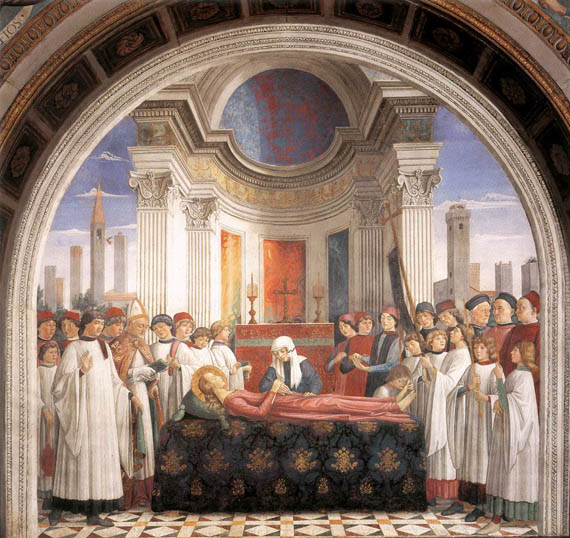
For her obsequies, in stark contrast, the beautiful saint is lying not on her wooden bed, but on a rich cloth and pillow in front of the altar. The living flowers have been changed into gold brocade that is shining on the black and dark turquoise cloth. Let us follow the inscription on her grave and look for the miracles depicted on the walls. Because the old nurse had held Fina's head for so long, her arms became paralyzed. Now, kneeling behind the bier in the center of the scene, she is healed by the touch of Saint Fina's hands. Another healing is taking place at the feet of the dead woman. Here, a blind boy regains his sight by touching his eyes to the saint's feet. A third miracle is taking place in the background on the left, where an angel has appeared to ring the death knell.
The painted pilasters that flanked the front pictorial zone of Ghirlandaio's early works are now integrated into the background of the picture as parts of a monumental sacred architecture. Behind the scene is an apse, which harmonizes with the chapel wall's tympanum at the top, and which also guides our eyes back to the centre of the scene. The vanishing point in this composition is the altar cross-flanked by two candles. Ghirlandaio would have found models for this architecture, which skillfully uses colorful marble, in the monumental tombs of his age - such as the work of Bernardo Rossellino in the church of Santa Croce in Florence. The immediate inspiration for the composition, however, was Fra Filippo Lippi's fresco in the choir of Prato Cathedral, the Obsequies of Saint Stephen. Ghirlandaio would later create another variation on this composition in a fresco for the Sassetti Chapel in Florence.
Obsequies of Saint Fina (Detail): 1473-75
Colleggiata, San Gimignano
_1473_75.jpg)
In the long row of expressive heads Ghirlandaio already reveals his unique ability to create convincing character studies, a skill that was to bring him fame and many well paid commissions. Some of those depicted do not seem to be taking part in the ceremony, while others are deeply moved. The server at the saint's feet is more interested in his processional cross than in the ceremony, and the server next to him is looking around to keep himself amused.
In the lower left corner on of the miracles can be seen: a blind choirboy who kisses her foot regains his sight.
Frescoes in Florence and Rome: 1480-84
The Vespucci family commissioned Ghirlandaio in 1480 to fresco a Saint Jerome in the church of Ognissanti as pendant to the Saint Augustine that Botticelli had recently painted on the chancel screens in the church. When these were later taken apart, both wall paintings were moved. In the process both were damaged and lost their original architectural context. They are now opposite each other on the walls of the church.
In the early 1480's Pope Sixtus IV brought a number of famous Tuscan and Umbrian artists to Rome in order to decorate his new court chapel, the Sistine Chapel. Ghirlandaio must already have made a name for himself with his commissions, primarily the frescoes for the Saint Fina Chapel, in order to be considered for a task of this importance. The chapel's ceiling would not be decorated with Michelangelo's famous frescoes until the reign of Sixtus' nephew, Julius II. Between 1481 and 1483, the walls of the chapel were covered with frescoes by Sandro Botticelli, Domenico Ghirlandaio, Cosimo Rosselli, Piero di Cosimo and Luca Signorelli - probably under the direction of Pietro Perugino.
After the successful interlude in Rome in 1482 Ghirlandaio received the official commission from the Signoria, the city government of Florence, to produce the decorations in the Sala dei Gigli in the town hall, the Palazzo Vecchio.
Saint Jerome in his Study: 1480
Ognissanti, Florence
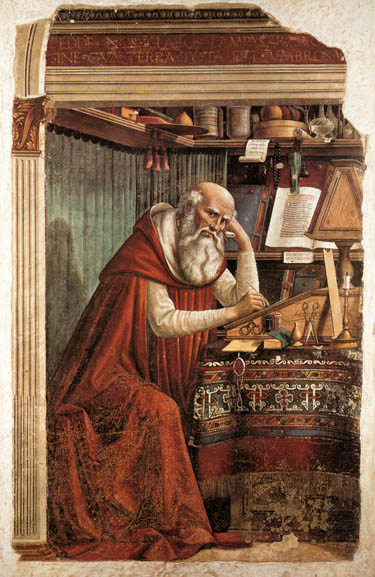
In 1480 Ghirlandaio frescoed in the church of Ognissanti (All Saints) a Saint Jerome that rivaled the Saint Augustine which Botticelli had painted there a short time before. This work, which was accomplished with excessive ease, is superficial and full of objects that suffocate and impoverish its impact. The direct comparison with the Botticelli Saint serves merely to underline an unsatisfactory period for Ghirlandaio.
Saint Jerome in his Study (Detail): 1480
Ognissanti, Florence
_1480.jpg)
In contrast with the Saint Jerome Ghirlandaio painted in Cercina, this Saint Jerome is not depicted as a penitent but as the scholarly translator of the Bible.
Calling of the Apostles: 1481
Cappella Sistina, Vatican
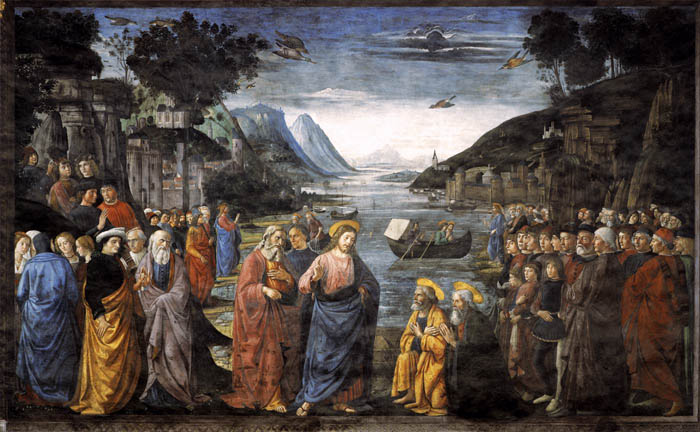
The fresco is from the cycle of the life of Christ in the Sistine Chapel, it is located in the third compartment on the north wall.
Vasari wrote: "Domenico represented Christ calling Peter and Andrew from their nets, and the Resurrection of Christ, the greater part of which is now destroyed, for it was above the door" Later, the Resurrection vanished completely in the destruction of the wall.
In the early 1480's Pope Sixtus IV brought a number of famous Tuscan and Umbrian artists to Rome in order to decorate his new court chapel, the Sistine Chapel. Ghirlandaio must already have made a name for himself with his commissions, primarily the frescoes for the Saint Fina Chapel, in order to be considered for a task of this importance. The chapel's ceiling would not be decorated with Michelangelo's famous frescoes until the reign of Sixtus' nephew, Julius II. Between 1481 and 1483, the walls of the chapel were covered with frescoes by Sandro Botticelli, Domenico Ghirlandaio, Cosimo Rosselli, Piero di Cosimo and others - probably under the direction of Pietro Perugino.
On the left are scenes from the life of Moses, and on the right scenes from the life of Christ, a typological arrangement that sees Moses as the predecessor of Christ. This cycle of frescoes became one of the major artistic achievements of the Italian Quattrocento. In accordance with the Pope's wishes, in each picture several episodes of a story were presented together, a practice that by this time was already becoming outdated. The two frescoes Ghirlandaio painted were the 'Calling of Saint Peter and Resurrection'. By Vasari's time the second fresco had been largely destroyed and an entirely new version was painted in the 16th century.
The surviving work is divided into two zones. In the foreground, on a shallow stage, Ghirlandaio depicted several groups of people, tightly packed together in rows. At the center Christ is blessing the kneeling brothers Simon, Peter and Andrew, his first disciples. They follow Him and appear again in the background on the right. There they witness Christ calling James and John, who are sitting in a boat mending their nets with their father, Zebedee.
The massiveness of the heavy garments worn by the figures in the main scene in the center foreground is reminiscent of Masaccio's frescoes in the Brancacci Chapel dating from about 1424 -1428. It is mainly Masaccio's Tribute Money that matches this one in terms of color, landscape, figure types.
It is at the sides of the picture field that Ghirlandaio dares to display his own developing style. The group of women on the left, including a woman in blue seen from behind, anticipates the female figures he paints in later works. In this fresco he also gives a free rein to the highly individual style of portraiture he had developed in the Vespucci and Saint Fina chapels. On the right, arranged in an exactly level row like pearls on a string, are members of the most influential Florentine families who maintained residences in Rome. In the center stands Giovanni Tornabuoni, representing the Medici family's merchant bank. He later became a sponsor of Ghirlandaio and was made the Pope's treasurer despite the enduring enmity between Pope Sixtus IV and the Medici.
His son Lorenzo Tornabuoni - in front of him, wearing a black garment - lived to see his wife die young and his family go bankrupt after his father's death. In 1477, Ghirlandaio painted two episodes from the life of Saint John the Baptist and two from the life of the Madonna for the mortuary chapel of Lorenzo's mother, Francesca Pitti Tornabuoni, in the church of Santa Maria sopra Minerva in Rome. According to Vasari, these works were very famous at the time; unfortunately they no longer exist, though two charming portraits of Lorenzo's wife, Giovanna Tornabuoni, who died young, have survived.
To the right of Giovanni Tornabuoni stands the humanist John Argyropoulos, wearing a white beard. He wrote commentaries on Aristotle and fled to Florence from Constantinople when the city fell to the Turks in 1453. A friend of Cosimo de' Medici, he spent fifteen years as a court scholar and professor of Greek at the University of Florence, until he was summoned to Rome by the Pope. He nonetheless continued to see himself as a Florentine, as Lorenzo de' Medici had accorded him civil rights there.
The nobleman beside him, with white hair and no hat, is thought to be either Francesco Soderini from Florence, or Raimondo Orsini from Rome. The young man behind him, with the brightly shining face, is thought to be Antonio Vespucci. Separate from the other Florentines, behind Christ, stands Diotisalvi Neroni, an earlier friend of Cosimo de' Medici. He lived in a more or less willing exile in Rome, as he was involved in plots against Cosimo's son Piero.
It was not only his skill in portraits but also his skill in landscapes, visible in the fresco in the Sistine Chapel, that made Ghirlandaio famous. The entire upper half of this work is devoted to an extensive landscape with a high horizon. The Sea of Galilee, hemmed in by hills and mountains, is snaking its way like a river into the background, where, in accordance with aerial perspective, the colors are paler and lighter. In the sky brightly colored birds are swooping - birds derived from Benozzo Gozzoli's 'Procession of the Magi', painted between 1459 and 1461 for the Florence Medici palace, and also from works by Domenico Veneziano.
Calling of the Apostles (Detail): 1481
Cappella Sistina, Vatican
_1481.jpg)
The group of characters on the right are all, or almost all, real portraits. Represented here are the most important components of the large Florentine colony in Rome - figures belonging to the most illustrious families of the city who had opened branches of their Florentine businesses in Rome, but above all the representatives of the Medici House banks of credit and commerce.
Giovanni Tornabuoni (whose sister was the wife of Piero de' Medici) figures prominently among the other characters portrayed. Head of the Medici Bank in Rome, he was so expert in financial and business affairs that he became the treasurer of Sixtus IV. Tornabuoni now is elderly, or so it would appear from his austere countenance and the deep wrinkles that furrow his brow and temples. Lorenzo, still almost a boy, stands in front of his father, his sad face revealing a certain feminine softness.
Further along the line, in profile, possibly another Tornabuoni is portrayed, the noble and cultivated Cecco. The character on the far right of the group is a member of the Vespucci family, Giovanni Antonio, whose sharp profile is illumined by a bright light that seems almost to lend him the suggestion of a smile. Another bare-headed gentleman, with white hair and a pensive expression is thought by some to be the Florentine Francesco Soderini.
Argyropulus is also among the Florentines, the old man with the resentful expression and rather weak face framed by a short white beard, and with his head covered by a strange, hard, almost prelatic hat. The Greek John Argyropulus, born in Constantinople but driven out by the Turks in 1453, had found refuge in Florence, in the cultivated circle of the Medici, whose guest he was for fifteen years. He had held the professorship of Greek at the university of Florence and Lorenzo il Magnifico had made him a citizen of Florence, which had become the city of his choice. When Argyropulus was called to Rome by Sixtus IV, he continued to regard himself as a Florentine and as such, with the others, Ghirlandaio portrayed him.
Calling of the Apostles (Detail): 1481
_1481_Three.jpg)
Decoration of the Sala del Gigli: 1482-84
Palazzo Vecchio, Florence
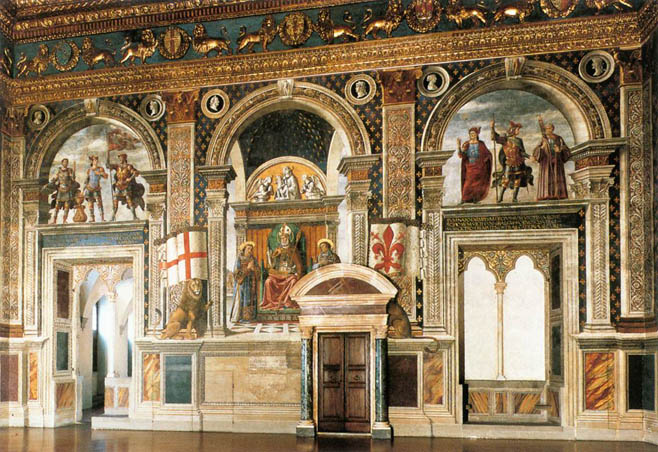
In 1482 Ghirlandaio received the official commission from the Signoria, the city government, to produce the decorations in the Sala dei Gigli in the town hall, the Palazzo Vecchio. Sandro Botticelli, Perugino and Piero del Pollaiolo had also been assigned to the task, but only Domenico accomplished the undertaking.
The most important consideration in the Sala dei Gigli was that the overall effect had to be magnificent, and the purpose of the monumental public work was to express the pride of the city and Republic of Florence.
Ghirlandaio divided one wall by means of painted pilasters, with three arches between them. The two outer arches are over a doorway and a blind window. The result is that the entire wall appears as a mighty triumphal arch. In the centre is Saint Zenobius, the patron saint of Florence, with two saintly deacons. In the tympanum above the bishop is a terracotta relief of the Madonna and angels, a work similar to many that were produced by the workshop of the Della Robbia family of artists. In the background on the left there is a view of Florence Cathedral. Under the side arches stand historical characters who embody civic and republican virtues. In these figures Ghirlandaio produced very detailed variations of Roman armor and the classical contrapposto postures, features portrayed with considerable archeological accuracy.
In the Sala dei Gigli the pictorial scheme is grandiose and the ancient figures depicted in the higher part of the fresco have an extraordinary energy. The deacons in the center, on the other hand, are weak, rather limp and monotonous, even in the colors, which have lost their original brightness and luster.
This work is not of a high quality. Already occupied with the Sassetti Chapel, which probably gave him more satisfaction, in the Sala dei Gigli he probably traced the outline of the painting only, leaving a large part of its execution to assistants. In addition to his two brothers David and Benedetto, and his brother-in-law Bastiano Mainardi, there were many other assistants: Bartolomeo di Giovanni, Francesco Granacci and Biagio d'Antonio di Firenze. It is impossible to attribute the responsibility to this or that assistant for the inferior parts of Ghirlandaio's fresco cycles, since he was also responsible for the parts that lack the animated style, vitality and mastery of color that were present in others. From these sometimes considerable discrepancies we must form a judgment about his work that makes him at once a marvelous interpreter of people and situations, a calm, almost monotonous narrator, or a tired and empty artist at times in search of the best, at others yielding to a commonplace routine.
Decoration of the Sala del Gigli (Detail): 1482-84
Palazzo Vecchio, Florence
_1482_84_Two.jpg)
Under the side arches stand historical characters who embody civic and republican virtues. In these figures Ghirlandaio produced very detailed variations of Roman armor and the classical contrapposto postures, features portrayed with considerable archeological accuracy. On the right Decius, Scipio and Cicero are depicted.
Last Supper Scenes
Ghirlandaio painted the scene of the Last Supper on several occasions within the space of a few years. In all three works of his that still remain (in the abbey of San Michele Arcangelo a Passignano in Tavernelle Val di Pesa, near Florence, in the Ognissanti in Florence, and in the San Marco, Florence), the basic arrangement is the same as that in the fresco by Andrea del Castagno in the Florentine Cenacolo di Sant'Apollonia dating from about 1450. The disciples are sitting at a long table in front of a rear wall that runs parallel to the picture plan. Christ is sitting in the center, and his favorite disciple John is leaning sadly against Him. To the right of Christ, in the place of honor, is the chief Apostle, Peter. Judas the traitor is the only one to be separated from the others: he is seated in front of the table.
Last Supper: 1476
Abbazia di San Michele Arcangelo a Passignano, Tavernelle Val di Pesa

Ghirlandaio painted the scene of the Last Supper on several occasions within the space of a few years. In all three works of his that still remain, the basic arrangement is the same as that in the fresco by Andrea del Castagno in the Florentine Cenacolo di Sant'Apollonia dating from about 1450. The disciples are sitting at a long table in front of a rear wall that runs parallel to the picture plan. Christ is sitting in the center, and His favorite disciple John is leaning sadly against Him. To the right of Christ, in the place of honor, is the chief Apostle, Peter. Judas the traitor is the only one to be separated from the others: he is seated in front of the table.
The earliest example of the Last Supper was painted in 1476 by Ghirlandaio in the abbey of San Michele Arcangelo a Passignano (in Tavernelle Val di Pesa, near Florence). This is strongly influenced by Andrea del Castagno. The Apostles and Christ are sitting together in a room with a flat ceiling that appears to be too low. Judas is sitting opposite Christ on a three-legged stool in front of the laid table. The figures are set back some distance from us, to a depth of three large floor tiles. The various emotions of the Apostles are indicated by stiff hand movements that scarcely seem alive and express little of the character of the individuals.
Last Supper: 1480

This version of the Last Supper, executed in the refectory of the convent of the Ognissanti was executed in the same year as the Saint Jerome in the church. It is a famous example of the Tuscan tradition of depicting the Last Supper in monastic refectories.
The scene is ample and characterized by vivid, animated lines, as was his style, but it draws on the structural organization that was characteristic of Andrea del Castagno. The spirit is typical of Ghirlandaio, who as ever remains rather psychologically superficial and uninterested in any form of dramatic expression. Jesus and the disciples are not particularly characterized and seem peaceful and rather at ease; even Judas, who though seated on his own in front of Christ, according to tradition, has a serene countenance and composed posture. The figures are sitting isolated next to each other in a row, and are not connected in any inner way. The epochal step taken by Leonardo with the communicating figures in his version in the refectory of the Santa Maria delle Grazie, Milan, becomes evident when comparing the two paintings. However, the overall effect is agreeable and there are some ingenious touches.
The lunettes offer an easy opportunity to the expert painter - a view of trees in a Tuscan garden beyond the wall; fruit-trees, cypresses, and an isolated palm-tree that appears rather incongruous in the surroundings. To the right, a peacock perches on a windowsill, while other birds flutter around in the crystalline air. The table is covered by a white tablecloth with blue embroidery. Plates, decanters, glasses, saltcellars and knives are carefully arranged in front of each table-guest, as are the bread and cherries. It might even be the realistic and serene representation of a Florentine table of the period.
Last Supper: ca 1486
San Marco, Florence
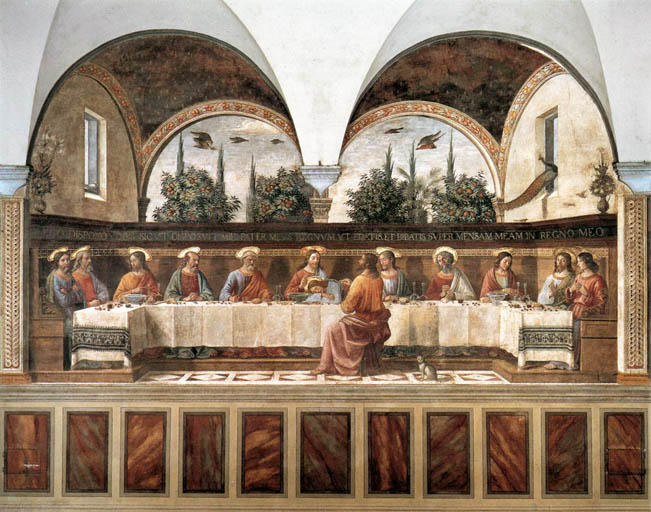
The last surviving version of Ghirlandaio's 'Last Supper' is in the refectory of the hostel of the San Marco convent.
It is pleasing to observe that chronicler's narration of his city and the rich bourgeois inhabitants who enlivened it in the middle of the 15th century. It is typical of the work of Ghirlandaio, who certainly sketched out the drawing and, at times, participated directly in its execution. Rendered without resorting to dramatic force, it reveals a serenity and great faithfulness to life. Note the impassive Judas, seated in front of Jesus and almost conversing with him. The supper takes place at a large table with a bright tablecloth, embroidered at the edges. Nothing about it is casual; the crockery, the decanters, the knives, the bread and the cherries, are carefully arranged in front of every guest.
With customary ease, Ghirlandaio fills the lunettes with large trees and birds in flight against a bright sky whose light is reflected onto the right-hand wall where an open window frames a perching peacock. The rest is in shadow. Two flower-displays complete the frame which encloses the space. A cat, waiting patiently for a hoped-for scrap of meat, lends a touch of intimacy and domesticity that is rarely lacking in Ghirlandaio.
Decoration of the Sassetti Chapel: 1482-85
Francesco Sassetti had gained his wealth as a partner in the French branches of the Medici bank in Avignon and Lyon. He also spent over ten years representing the Medici bank in Genoa and occasionally in Geneva. By the end of the 1470's, Sassetti had already acquired the rights of patronage to a small side chapel, the second to the right of the choir in the Florentine church of Santa Trinità. Ghirlandaio was commissioned to paint the chapel, which he decorated with frescoes with scenes from the life of Saint Francis of Assisi between 1482 and 1485.
Ghirlandaio also executed the altarpiece of the chapel. This altarpiece the Adoration of the Shepherds is the key work in the chapel both in subject and in artistic merit.
In the Sassetti Chapel the artist combined secular, religious, and classical themes to produce a unique masterpiece.
View of the Sassetti Chapel: ca 1485
Santa Trinità, Florence
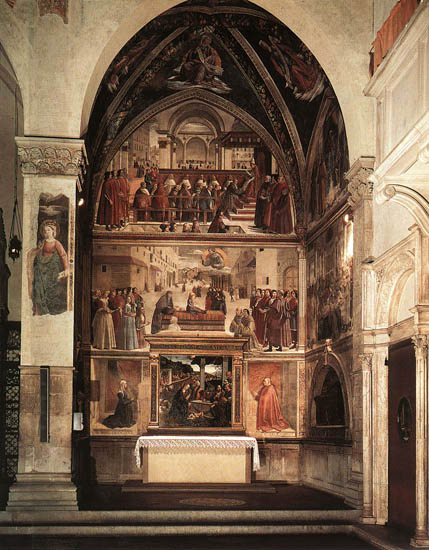
"He did a chapel in Santa Trinità for Francesco Sassetti with stories of Saint Francis, an admirable work, remarkable for its grace, finish and delicacy" (Vasari).
Francesco Sassetti had gained his wealth as a partner in the French branches of the Medici bank in Avignon and Lyon. He also spent over ten years representing the Medici bank in Genoa and occasionally in Geneva. But he was not always successful later on in his role as the chairman of the bank, and in 1484 was replaced by Giovanni Tornabuoni. By the end of the 1470's, Sassetti had already acquired the rights of patronage to a small side chapel, the second to the right of the choir in the Florentine church of Santa Trinità. It was probable at this time that Ghirlandaio was commissioned to paint the chapel, which he decorated with frescoes between 1482 and 1485.
The donor and his wife had themselves portrayed as life-sized figures kneeling in prayer at the side of the altarpiece the Adoration of the Shepherds. The donors are adoring the Christ Child, just like the shepherds in the panel painting. An incomplete inscription under their portraits names the day on which the chapel was consecrated, 25 December 1485, hence also the date by which it would have been completed. This year corresponds with the complete inscription on the altarpiece. In the Sassetti Chapel the artist combined secular, religious, and classical themes to produce a unique masterpiece.
In the scenes from the life of Saint Francis of Assisi, Ghirlandaio incorporated portraits of contemporaries and views of Florence: he recreated religious events to the Florence of his day. In contrast to the newly built Saint Fina Chapel, the Sassetti Chapel was old and in the Gothic style. On each of its three walls Ghirlandaio painted two scenes from the life of Saint Francis, completed by a seventh fresco in the tympanum over the arched entrance to the chapel. At the crown of the entrance arch, the Sassetti coat of arms is surrounded by a garland of fruit, a sculptural work made of terracotta. The fresco in the tympanum above shows a sibyl prophesying Christ's dominion over the world to Emperor Augustus. The fresco idealizes the classical period as the precursor to the Christian age, and this provides a link with the chapel's high point, the altarpiece, which depicts the birth of Christ. The grisaille figure of David outside the chapel can also be interpreted in this way.
On the two side walls of the chapel are the black marble sarcophagi of Francesco Sassetti and his wife Nera Corsi, set into niches with round arches. Here the sculptural decorations are dominated by classical motifs; the sculptor Giuliano da Sangallo is sometimes identified as the artist. The tomb niches are framed by grisaille frescoes, in which Ghirlandaio cites motifs from classical coins. Above each are two monumental frescoes by Ghirlandaio, which clearly owe a debt to traditional images. There are still echoes of the pictorial order established by Giotto in Assisi over 160 years earlier. Ghirlandaio studied Giotto's frescoes in the Bardi Chapel, dating from about 1325, in the Franciscan church of Santa Croce in Florence, and made direct use of them.
Portrait of the Donor Nera Corsi Sassetti: ca 1485
Santa Trinità, Florence
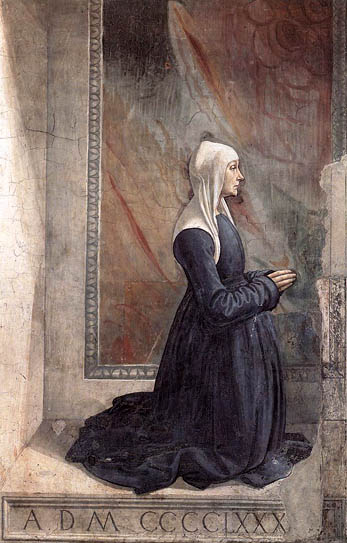
"In two pictures on either side he painted Francesco Sassetti kneeling, and Madonna Nera, his wife and her children, the latter being in the scene above where the boy is raised to life, with some beautiful maidens of the same family" (Vasari).
The two donors are in prayer on either side of the altar, as if they are taking part in the Adoration of the Shepherds depicted on the altarpiece. Linking the frescoes and the central panel painting in this way, Ghirlandaio creates what is almost a triptych. Astonishingly enough, the wife, Nera Corsi Sassetti, is occupying the traditionally more distinguished position on the right of the religious scene.
At the base is the painted inscription: A.D. MCCCCLXXX. XV decembris. This could be the initial date of the work whose conclusion is in the great altarpiece with the Nativity, dated 1485.
Portrait of the Donor Francesco Sassetti: ca 1485
Santa Trinità, Florence
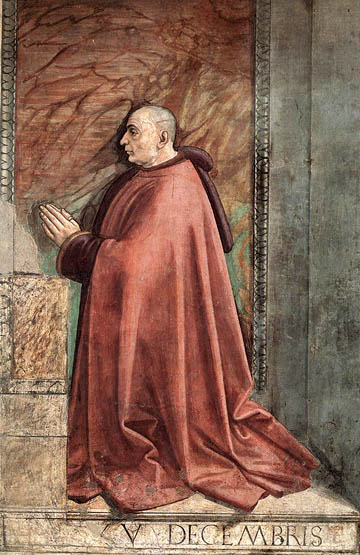
"In two pictures on either side he painted Francesco Sassetti kneeling, and Madonna Nera, his wife and her children, the latter being in the scene above where the boy is raised to life, with some beautiful maidens of the same family" (Vasari).
At the sides of the altar Ghirlandaio painted full-length portraits of his patron Francesco Sassetti, and his wife Nera. Linking the frescoes and the central panel painting in this way Ghirlandaio creates what is almost a triptych.
Francesco Sassetti's dealings as a patron of the arts were not characterized by commercial acumen or sound business sense. It is almost as if he wanted to record his pointed rejection of the commercial mentality. As his reputation as a banker faded, people made fun of him by saying that he would rather study Cicero than his account books.
At the base is the painted inscription: A.D. MCCCCLXXX. XV decembris. This could be the initial date of the work whose conclusion is in the great altarpiece with the Nativity, dated 1485.
Sibyl: ca 1485
Santa Trinità, Florence

Four female prophets are depicted in the vaulting of the chapel. They are enthroned on clouds in front of a sky-blue background and are holding out their prophecies on banderoles. They are wearing marvelously colored garments and dresses with high waistlines. The ribs of the Gothic vault are magnificently decorated with painted garlands of fruit symbolizing the wealth, prosperity and fertility of both the donor family and the city of Florence.
Meeting of Augustus and the Sibyl: ca 1485
Santa Trinità, Florence
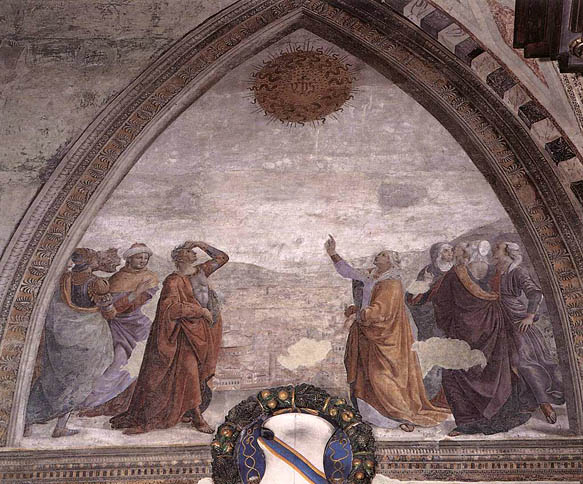
The Tiburtine Sibyl shows the Roman Emperor Augustus the shining gold vision of the name of Jesus abbreviated to "IHS". This prophecy to the pagan emperor is fulfilled. In the altar painting of the chapel: the Birth of Christ. The figures are in a raised position with a view over classical Rome in which the Pantheon and Trajan's Column can be seen.
David: ca 1485
Santa Trinità, Florence

The youth David, who, armed only with a catapult, vanquished the giant Goliath, was a symbol of the pride and power of the republic of Florence. He was also linked to the name of the donor: the catapult was part of the Sassetti family's coat-of-arms because their name was similar to the Italian word for throwing stones (sassata). The donor's coat-of-arms can be seen on David's shield. Catapults also flank the coat-of-arms above the chapel and are depicted in the sculptural ornamentation in the tomb niches, in the chapel.
Saint Francis Cycle in the Sassetti Chapel
On each of the three walls of the Sassetti Chapel Ghirlandaio painted two scenes from the life of Saint Francis. The scenes are the 'Renunciation of Worldly Goods' and the 'Stigmata of Saint Francis' (on the left wall), the 'Test of Fire before the Sultan' and the 'Obsequies of St Francis' (on the right wall), the 'Confirmation of the Rule' and the 'Resurrection of the Boy' (on the rear wall above the altar).
Renunciation of Worldly Goods: 1482-85
Santa Trinità, Florence
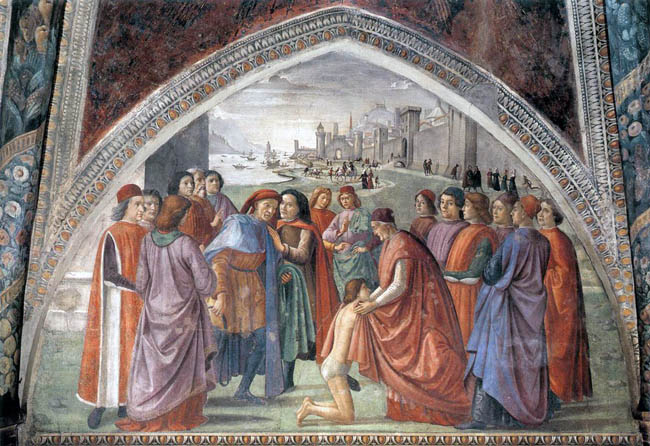
The Saint Francis cycle in the Sassetti Chapel starts in the tympanum on the left wall with the 'Renunciation of Worldly Goods', the scene in which the saint leaves his father and renounces his inheritance. It is perhaps surprising that this should be chosen as the theme for the mortuary chapel of a rich banker, but there were other bankers who considered the theme of poverty in response to God's call suitable for their funeral monuments - an example is Giotto's Saint Francis cycle in the Bardi Chapel, which was also commissioned by a banker.
The young Saint Francis renounced the world by laying aside his expensive clothes and placing himself naked into the care of the Church. A churchman is taking him into protection under his cloak - the same gesture used by a Madonna of Mercy. Spectators are refraining the horrified father carrying his son's clothes across his arm.
It should be noted that the stories, which are higher up and further from view, were probably left to his assistants: the 'Renunciation of Worldly Goods', the 'Test of Fire before the Sultan and the Stigmata'. But even here the master's hand and eye return: in a facial expression, in the delicacy of certain effects of light, in a distant landscape, or in some ecstatic abandonment.
Renunciation of Worldly Goods (Detail): 1482-85
Santa Trinità, Florence
_1482_85.jpg)
In the background, a town wall with towers guides our eyes right into the distance. It is thought this is Genoa, where the donor spent ten years directing the local branch of the Medici bank. The shore is populated by many figures in groups, diminishing in size to create a sense of distance.
Renunciation of Worldly Goods (Detail): 1482-85
Santa Trinità, Florence
_1482_85_Two.jpg)
Stigmata of Saint Francis: 1482-85
Santa Trinità, Florence
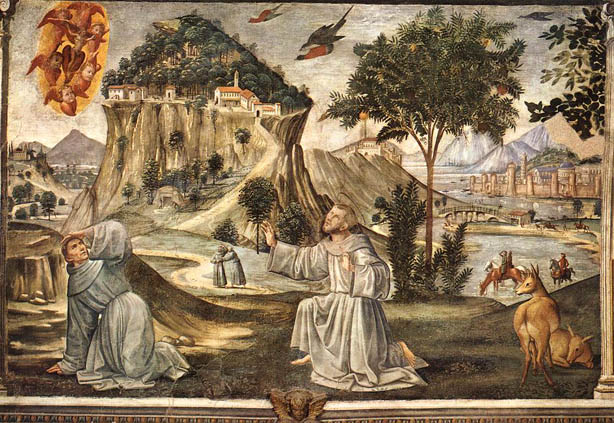
The second scene of the Saint Francis cycle in the Sassetti Chapel is underneath the 'Renunciation' on the left wall: The 'Stigmata of Saint Francis'. This event, the most important in the saint's life, encouraged his followers to raise him to messianic heights, for the miracle of the stigmata was the climax of his imitation of Christ. It is noticeable that this central event is not depicted in a prominent location in the chapel. Within the individual scenes of the cycle Ghirlandaio follows the compositional structure of postures of the main figures in Giotto's work, still his compulsory model. But the background proves that the frescoes belong to a new artistic era.
At roughly the same time, in about 1485, a Florentine sculptor of the same age created this scene showing the stigmatization in marble for the pulpit of the Franciscan church of S. Croce in Florence: his name was Benedetto da Maiano, and he had, like Ghirlandaio, been commissioned by the wealthy banker Pietro Mellini to create a funeral monument in the form of a pulpit. The similarity between the two scenes is so great that one is forced to assume that one of the two artists copied the other in his own medium. The remaining scenes about Saint Francis on Benedetto's pulpit are also in part comparable with Ghirlandaio's frescoes. This raises the question whether the sculptor was influenced by the painter, or the reverse, or whether both of them made use of the same models. Here the two artistic genres of painting and sculpture were competing with each other.
Saint Francis led his life entirely according to the example of Christ. Two years before his death in 1224, he was miraculously marked with the wounds of the crucified Christ. This climax in the saint's life took place on the slopes of the La Verna mountain, where seraphim appeared to him bearing a vision of the crucified Christ and he received the wounds produced by the nails and lance.
It should be noted that the stories, which are higher up and further from view, were probably left to his assistants: the 'Renunciation of Worldly Goods', the 'Test of Fire before the Sultan' and the 'Stigmata'.
Stigmata of Saint Francis (Detail): 1482-85
Santa Trinità, Florence
_1482_85.jpg)
On mount La Verna in the Tuscan province of Arezzo, 1.128 meters above sea level, is a famous monastery founded by Saint Francis. Ghirlandaio shows a path that leads over a ramp to the gate of this monastery. Beyond the gate we clearly make out the monastery church and a courtyard and well. At the bottom of the hill, two figures are busy by a grotto from which a spring is flowing. Much in Ghirlandaio's picture is reminiscent of real topographic conditions.
Stigmata of Saint Francis (Detail): 1482-85
Santa Trinità, Florence
_1482_85_Two.jpg)
Three riders have stopped by a river in order to let their horses drink. They appear to be seeing the vision of Saint Francis in the distance. This contradicts the legend, which stated that there were no witnesses. In the background is an idealized view of the city of Pisa, which had been conquered by Florence in 1406.
Test of Fire before the Sultan: 1482-85
Santa Trinità, Florence
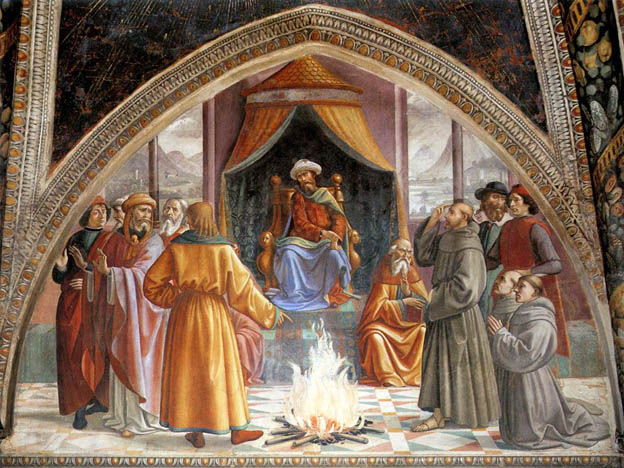
This scene is in the tympanum on the right wall.
Saint Francis appeared before the Sultan in order to prove the strength of his faith and the power of his God. He is prepared to walk barefoot through a blazing fire for his faith. The bearded Muslim scholars or religious leaders on the left do not appear to be prepared to venture the same for their faith.
It should be noted that the stories of the cycle, which are higher up and further from view, were probably left to his assistants: the 'Renunciation of Worldly Goods', the 'Test of Fire before the Sultan and the Stigmata'.
Obsequies of Saint Francis: 1482-85
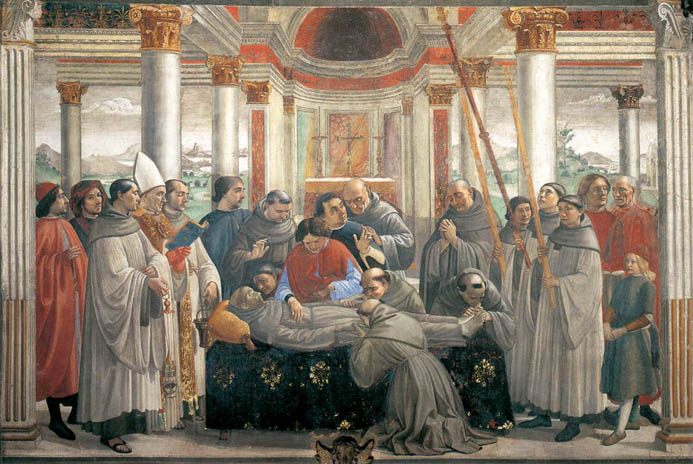
This scene is underneath the 'Test by Fire before the Sultan' on the right wall.
Grieving Franciscan brothers encircle the dead founder of their order. Some are kneeling in order to kiss the stigmata on his hands and feet. A figure dressed in red is bending over the dead body in order to examine the wound in the Saint's side. This is Girolamo who like the Doubting Thomas with Christ, doubted the stigmatization of Saint Francis until he was able to touch the wound.
To the left a priest is celebrating the funeral mass wearing a pair of spectacles on his nose - still an unusual motif, for Canon van der Paele in Jan van Eyck's Bruges Madonna of 1436 is still holding his spectacles, together with his book, in his hand. Vasari took such a liking to Ghirlandaio's priest that he wrote that he "is so real that only the absence of sound proves him to be a painted image". The distribution of the groups of figures is another variation - as is the 'Obsequies in the Saint Fina Chapel' - of the composition created by Filippo Lippi in his 'Obsequies of Saint Stephen' in Prato Cathedral. The sacred architecture is also derived from Lippi's fresco; Ghirlandaio, however, opens up his imaginary architecture at both sides, as he does in San Gimignano, with view onto a landscape.
To the right is the Franciscan Order in all its simplicity, and with its kindly, somewhat rustic looking monks. The church in the background has a sober appearance, though it gives on to a Tuscan countryside lush with rivers and streams. Here too, lesser-known characters are portrayed, undoubtedly either the monks of the nearby church of Ognissanti, so dear to Domenico, or those of Santa Trinità.
Ghirlandaio had certainly been to see Giotto's fresco in Santa Croce, since he has used the same composition and distribution of masses in this scene. Indeed, the teachings of Giotto, and his style, must not be forgotten. But here Domenico is more joyful and serene. The delicate touches of grey and white can only be his. His too is the light that streams over the faces, that gives a warm serenity and infinite peace to the countenance of Francis, motionless in death, and that falls on the gilded yellow of the pillow, on the reds and blues, and on the white clouds in the sky. There is almost a country atmosphere about it, an air of church-square festivity, and there is a masterly touch in the interplay of carefully spaced hands, which assume an almost musical quality through Domenico's artistry.
Confirmation of the Rule: 1482-85
Santa Trinità, Florence

At the best site in the chapel, highly visible above the altar, are the most famous scenes of the cycle, though they are not in any way the most important stages of the stories of Saint Francis. In these scenes Ghirlandaio succeeded in creating his own independent and unique images. Ghirlandaio moves the scene of the represented events from Rome where they took place to Florence.
The events in the 'Confirmation of the Rule' are taking place on the most important square in Florence, the Piazza della Signoria. The fresco represents the visit of the Saint to Rome to obtain the confirmation of his order from Pope Honorius III.
In the center is the consistory hall decorated with gold drapes, and with prelates and personages witnessing the Pope's blessing. The Medici family are also present, honoring Sassetti. Lorenzo de' Medici the Magnificent is easily recognizable on the right side, his profile rendered unhandsome by that squashed nose which deprived him (and his mother) of any sense of taste or smell and meant that he always spoke hoarsely, and his olive-complexioned face framed by a brown shock of rather shaggy hair. To his right is Antonio Pucci, now somewhat advanced in years, and Francesco Sassetti dressed in red; his young son Teodoro is by his side.
On the left, dressed in red, stand the sons of the donor: Galeozzo, Cosimo, and also Teodoro, who had already died in 1478. In order to be able to fit all figures into the picture, some of the figures that had already been painted in the fresco had to be scratched off the wall. Thus, next to the donor's sons, there appears a monk without a body: he had been over-painted, but can now be seen again shining through the insufficiently thick layer of color that was painted over him.
Coming up the steps with their tutor are Lorenzo's two elder sons, Piero and Giovanni, and with them Giulio, the orphan of Giuliano who was killed in the Pazzi Conspiracy, with their blond mops of hair, the solemn face of the former and the rather vague expression of the other who follows. Their tutor is Agnolo Poliziano, a man of letters, the composer of the 'Stanze', and a friend of Lorenzo who honored him in his house.
The three boys are with Matteo Franco, the kinder and more favored tutor, whose descriptions with the pen accompany Domenico's paint-brush that lingers with such affectionate care on the pinkish, childlike features. The same precision is repeated by Ghirlandaio in the sharp profile of Franco's sworn enemy, Luigi Pulci, a caustic and irreverent character whose soul was imbued with a violent laical paganism. Harsh, bitter, poor and melancholy, he was protected mainly by Lucrezia Tornabuoni.
In the background is Florence, with its most celebrated buildings: the Loggia dei Lanzia, the façade of Palazzo Vecchio with its solemn raised podium that was later replaced by the present-day flight of steps; the gilded Marzocco lion (symbol of Florentine democracy); a back-drop of houses in the far left-hand corner and a bell-tower (possibly that of San Piero Scheraggio) where the Uffizi would later be built. In the background is a bustling of small figures, citizens and curious onlookers, possibly an opening and closing of shutters and, in places, a glimmering of gold in the capitals and arch of the consistory hall. A faint clear light passes over the soft colors, mellowing even the severity of the stones in the distant buildings. It is the history of Florence, fixed for ever, that passes by and comes to rest in front of us.
Resurrection of the Boy: 1482-85

The official prestige value of the upper picture on the main chapel wall (the 'Confirmation of the Rule') is clear. In contrast, the fresco beneath it, directly above the altarpiece, is devoted to the Sassetti family's private history. In 1478, the year of the Pazzi Plot, their son Teodoro died; but a few months later Nera Corsi Sassetti gave birth to a second son. As they felt him to be a gift from God, they made yet another change in the plans for the altar wall in their mortuary chapel. Ghirlandaio had to abandon his design for a scene showing the appearance of Saint Francis in Arles, for which preliminary drawings still exist, and paint the 'Resurrection of the Boy'. This was how the Sassetti intended to express their gratitude for their new-born son Teodoro II. The events in the Resurrection of the Boy are taking place just outside the church of Santa Trinità at the Ponte Santa Trinità.
"In it he represented the Ponte Santa Trinità (the old one, by Taddeo Gaddi; the present one was built by Ammannati almost a hundred years later) with the palace of the Spini, the first scene showing the appearance of Saint Francis in the air to raise a child of that family... and other figures who are marveling and rejoicing at the miracle, affording no little pleasure to the rest of us. Among them are portraits of Agnolo Acciaioli, Palla Strozzi." (Vasari)
While playing, a boy falls out of the windows of the Palazzo Spini. A red ball falling to the street below him. Some passers-by see the falling child, rush up in help, but it is too late: the child is dead. The boy who met with the fatal accident is already lying on a bier surrounded by mourners. Then, however, two Franciscans succeed in interceding with Saint Francis on their behalf, and the child is brought back to life. The artist moved this miracle from Rome where it actually took place, to Florence - just outside the church in which the picture is painted in order to be able to incorporate many of the portraits requested by the donor in the groups of onlookers.
Adoration of the Shepherds: 1482-85
Santa Trinità, Florence

"He painted in tempera, as a companion to this work, a 'Nativity of Christ' which must excite the wonder of every thinking man, introducing his own portrait and some heads of shepherds, which are considered divine" (Vasari).
The Sassetti Chapel is consecrated to the birth of Christ, and as a result much in the chapel is conceived with that event in mind. The altarpiece the 'Adoration of the Shepherds' is the chapel 's key work not only in subject, but also in artistic merit. This composition was so successful that other artists frequently repeated it. Ghirlandaio himself appears in the scene, dressed as a shepherd. He is even allowed to come closer to the Christ Child than the donors, who appear in frescoes to the right and left, praying outside the confines of the panel. The artist, who is leading the shepherds, is kneeling and bringing the miracle of the birth of Christ to the attention of both the shepherds and the observers of the picture. His left hand, with which he is pointing to the Christ Child, is finely drawn and is superbly modeled in three dimensions. With his right hand, his painting hand, he is pointing to his chest, as he does in a later fresco in the Tornabuoni Chapel. As Ghirlandaio is pointing both at the child and the garlands on the Roman marble sarcophagus, it is possible that the gesture is saying: "This holy child was painted for you by me, the garland-maker Ghirlandaio."
The classical sarcophagus in the picture is not just a manger for the ox and ass. It also has an iconographical significance indicated by the Latin inscription along its front:
Ense cadens. Solymo. Pompei Pului[us] Augur Numen. Ait. Quae me conteg[it] Urna Dabit.
(While Fulvi(us), augur of Pompey, was falling by the sword in Jerusalem he said: the urn that covers (conceals) me shall bring forth a god.)
This is an ancient prophecy by Fulvius. The animals' manger will serve as a crib for the Christ Child. In his 'Adoration of the Shepherds', Ghirlandaio combines this reference to the Roman classical age with knowledge of Flemish art and turns them into an integrated whole.
An historic event that took place a few years before this work was painted clearly left its mark behind on Ghirlandaio's work. An altarpiece ordered by Tommaso Portinari from Hugo van der Goes in Bruges reached Florence in May 1483. Florentine artists saw van der Goes' 'Adoration of the Shepherds' as a shining comet showing new ways of painting. In Ghirlandaio's altarpiece, the shepherds pushing their way into the picture from the right, with their harsh, life-like features, are drawn directly from this Flemish model. Ghirlandaio's landscape in the background also displays features from north of the Alps.
Frescoes in the Tornabuoni Chapel of the Santa Maria Novella: 1486-90
Even before Ghirlandaio had finished the ensemble in the Sassetti Chapel in Santa Trinità, it was already attracting members of the Florentine upper class who were deeply impressed. So before work in the chapel was completed, Ghirlandaio was commissioned to carry out another large-scale project. His task was now to paint the apsidal chapel of Santa Maria Novella. On 1 September 1484, he and his brother Davide signed a contract with Giovanni Tornabuoni, a man whose wealth, power and noble descent ensured his position at the side of the Medici. In just four years, between 1486 and 1490, Ghirlandaio and his workshop completed a monumental work that was entirely to Tornabuoni's satisfaction.
Using classical pilasters and entablatures, Ghirlandaio divided the two enormous walls under the wall rib in this Gothic chapel into six horizontally rectangular picture fields. They are placed above each other in three layers and are crowned by a pointed tympanum. The chapel's front wall, in contrast, has three high-pointed arch windows that provide room on either side for three smaller, vertically rectangular pictures, as well as the large tympanum above them. Here Ghirlandaio designed not just the colorful stained glass windows, still at their original location, he also created the altarpiece and its back. These panel paintings, however, are no longer here, they are scattered in different museums. The vaulting of the chapel contains the Evangelists. On the left wall Domenico frescoed the stories of Mary, on the right the life of Saint John the Baptist. Both stories unfold so smoothly, and in the context of the purest Christian tradition, that it is unnecessary to look for their guiding principle and inspiration outside the Bible and the most elementary religious teaching.
The overall conception of the chapel has been thought through carefully, right down to the direction of the light. As in the Last Supper in the church of Ognissanti, Ghirlandaio rigorously integrated into his scenes the way in which the interior was lit through the three windows: the scenes on the left wall are lit from the right, and those on the right wall from the left - as though from the real windows.
It was only possible for Ghirlandaio to produce such an extensive work in four years by using assistants from his large workshop. At this time his brothers, brother-in-low and several students were working there; the young Michelangelo is thought to have been working there as an assistant, though this cannot be proved. It is likely that Ghirlandaio produced all the plans, but painted only parts of the works himself. The magnificent portraits and the atmospheric, well balanced spaces in the lower picture fields suggest that Ghirlandaio himself painted them. The upper pictures are of poorer quality, here - in the dizzy heights where pictures could be seen only from a distance - he allowed others to do the painting.
With the wall and vault frescoes, panel paintings and designs for the windows, Ghirlandaio created a magnificent composite work which is a major example of chapel decoration at the end of the Quattrocento. This is the most famous and most celebrated work of Ghirlandaio, his reputation being based principally on it. The frescoes were recently restored (1996).
View along the Nave to the Tornabuoni Chapel
Santa Maria Novella, Florence
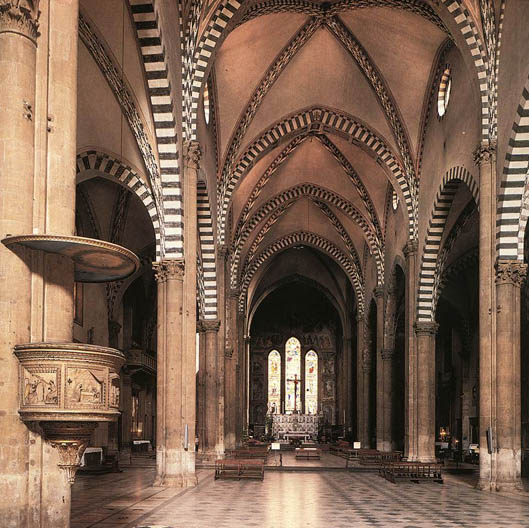
The church of Santa Maria Novella was founded in 1279. According to tradition, the church was designed by Dominican lay brothers inspired by the examples of Gothic Cistercian architecture. The construction was finished in 1357, the church was consecrated by Pope Martin V in 1420.
The church is in the form of a "T" having a nave and two aisles. The ceiling is vaulted and the arches and windows are pointed. The arches of the three naves are sustained by clusters of slim stone columns with sculpted leaf capitals.
The nave leads to the main chapel which until 1485 was under the patronage of the Ricci and Sassetti families. The patronage was took over by Giovanni Tornabuoni in 1485.
View of the Tornabuoni Chapel: 1485-90
Santa Maria Novella, Florence
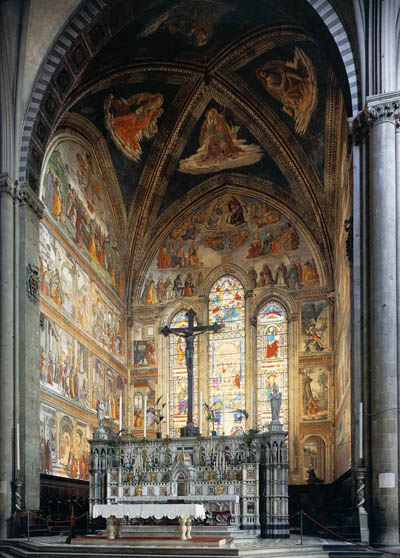
One of Ghirlandaio's major commissions was the series of almost twenty frescoes of the lives of Mary and John the Baptist that fills the Gothic Chancel (Cappella Maggiore) of Santa Maria Novella in Florence. Ghirlandaio also designed the chapel's stained-glass windows. The patron was the wealthy Giovanni Tornabuoni, the relative by marriage of the Medici, and Ghirlandaio was under such pressure that he enlisted his whole shop in the undertaking, including possibly a thirteen-year-old apprentice called Michelangelo Buonarroti.
The fresco compositions are framed by a highly decorative Renaissance architecture closely connected with the ideas of the architect Giuliano da Sangallo and full of elaborate detail.
Frescoes on the Left Wall: Stories of the Virgin
(1) Expulsion of Joachim from the Temple
(2) Birth of Mary
(3) Presentation of the Virgin at the Temple
(4) Marriage of Mary
(5) Adoration of the Magi
(6) Slaughter of the Innocents
(7) Death and Assumption of the Virgin.
Expulsion of Joachim from the Temple: 1486-90
Cappella Tornabuoni, Santa Maria Novella, Florence
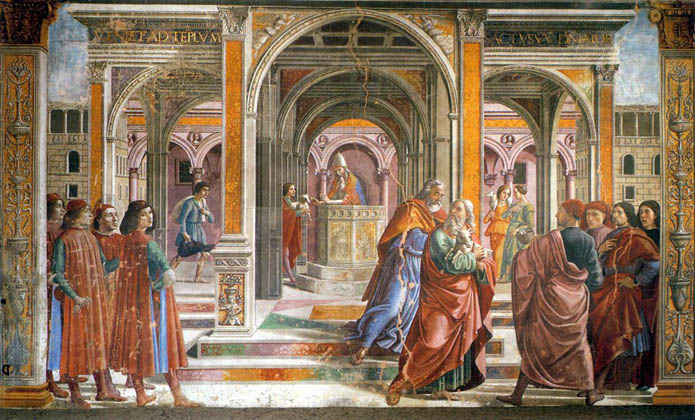
The narration of the story of Mary on the left wall of the chapel starts at the bottom at the entrance to the chapel with the 'Expulsion of Joachim from the Temple'.
In the center of the loggia with broad round arches and built on a cross-shaped ground plan, a high priest is receiving sacrificial lambs at the altar where a fire is burning. As the old Joachim does not yet have any descendants, he is not allowed to take part in the sacrificial rite, and is sent away. Symmetrical groups of Florentine citizens frame this biblical scene, and in the group on the right, the artist has depicted himself and some members of his family.
This episode follows the traditional lines of composition. Of significance here is the architecture, which the artist obviously felt was more important than the events. In the upper half of the painting it takes up more space than the figures, who occupy only the bottom part of the picture. The most important figures - and not only the biblical ones - are standing at the front edge of the picture. All the other scenes follow this basic principle.
In the background, Ghirlandaio's depiction of the widely spaced loggia and its medallions is a direct quotation of the Spedale degli Innocenti, the foundling hospital in Florence designed by Brunelleschi. Interestingly enough, there is a repetition of this façade, constructed shortly after Ghirlandaio's frescoes were painted, that can be seen when leaving the church of Santa Maria Novella at the other end of the piazza by the Spedale di San Paolo (built 1489 -1498).
Above the portraits are two palaces whose lines run parallel with those of the temple. Comparable buildings, with rusticated lower stories and open upper stories, largely characterize the appearance of Florence to this day. This was one way in which Ghirlandaio repeatedly brought the city into his paintings.
Contemporaries of the artist and clients are present as spectators and witnesses of the 'Expulsion of Joachim', and because of their fashionable clothing and shoes and their vain hairstyles they differ conspicuously from the biblical participants. It is thought that the noblemen on the left include the client's son, Lorenzo Tornabuoni, and his friend Piero, the son of Lorenzo de' Medici. In the group at the right Ghirlandaio depicts famous contemporary artists (including himself) who can be identified from the description of Vasari as Alesso Baldovinetti, Bastiano Mainardi, Davide and Domenico Ghirlandaio.
Expulsion of Joachim from the Temple (Detail): 1486-90
Cappella Tornabuoni, Santa Maria Novella, Florence
_1486_90.jpg)
In the group at the right Ghirlandaio depicts famous contemporary artists (including himself) who can be identified from the description of Vasari as Alesso Baldovinetti, Bastiano Mainardi, Davide and Domenico Ghirlandaio.
Vasari wrote that "one of these, the old, clean-shaven man in a red cap, is Alesso Baldovinetti, Domenico's master in painting and mosaic.", who was probably portrayed from life since he died later, in 1499. "Another, standing bareheaded, his hand at his side, in a red mantle, with a blue vest beneath, is Domenico himself, drawn with the help of a mirror."
"The man with black hair and thick lips is Bastiano da San Gimignano, the artist's pupil and brother-in-law." It is possible that he became part of Ghirlandaio's circle at the time of the Stories of Saint Fina. Subsequently he married Alessandra, Domenico's sister, and became his most well-known and recognizable disciple. "and the other, with his back turned and wearing a cap, is Davide Ghirlandaio, his brother, the painter".
Birth of Mary: 1486-90
Cappella Tornabuoni, Santa Maria Novella, Florence

"The second scene is the Nativity of the Virgin, executed with great diligence. Among other remarkable things it contains a window which lights the chamber and actually deceives the beholder." (Vasari).
The second scene, the 'Birth of Mary', is one of the finest creations in the chapel. The space, which is skillfully constructed along perspective lines, opens up like a display case. It is opulently decorated, with a relief frieze in which putti are dancing a roundel. They appear to be delighting in the birth of the Virgin Mary, for as the Latin inscription at their feet proclaims:
"Nativitas tua genitrix virgo gaudium annunziavit universo mundo"
(Thy birth, O Virgin and Mother of God, brings joy to all the world).
This frieze of putti was inspired by Florentine sculpture, being reminiscent of the two cantorias in the Cathedral by Donatello and Luca della Robbia, created about 1435.
The daughter of the donor, Ludovica Tornabuoni, is entering the birth room from the left with her retinue. She is noticed by the kneeling nurse, who turns and looks at her - an action Ghirlandaio uses to forge a direct link between the biblical and the contemporary. The stiff appearance of this young aristocrat forms a stark contrast to the graceful movements of the maid pouring water. There is an isolated preliminary study for this figure that tells us a great deal about Ghirlandaio's method of drawing using a network of parallel hatching.
Birth of Mary (Detail): 1486-90
Cappella Tornabuoni, Santa Maria Novella, Florence
_1486_90.jpg)
"One of (the women) holds the Child in her arms and makes it laugh by smiling, with a feminine grace truly worthy of a work of this great genius, each figure being distinguished in its various expressions". (Vasari)
Here Ghirlandaio succeeds in convincingly continuing the rear wall of the real chapel, which has windows, into the depth of the picture, where there is also a painted window. As a result, part of the frieze of dancing putti playing instruments is in the light, and part in shadow. The figures of the nurses are also captivatingly vivid the joy of the lovely woman holding the child lights up her bright face. And the marvelous moving figure of the woman pouring water gives the picture a look of everyday life.
Birth of Mary (Detail): 1486-90
_1486_90_Two.jpg)
In the top left-hand corner, almost unnoticed on the steps, we see Anne and Joachim embrace. This represents the kiss at the Golden Gate, which, through the will of God, made Anne pregnant after years of being barren. Ludovica Tornabuoni, followed by four companions, is walking towards the bed in order to visit the woman who has just given birth. This young girl, who is depicted in profile, is wearing a magnificent brocade garment and standing very upright, like the pillar behind her, unmoving and proud.
Birth of Mary (Detail): 1486-90
Cappella Tornabuoni, Santa Maria Novella, Florence
_1486_90_Three.jpg)
Standing out from the others in profile is a young woman, almost a girl, wearing gold embroidered brocade, possibly for the first time dressed like a lady and a little embarrassed by the stiffness of the garment and its large, rather long sleeves. It might be Giovanna Tornabuoni, the banker's only daughter.
Presentation of the Virgin at the Temple: 1486-90
Cappella Tornabuoni, Santa Maria Novella, Florence
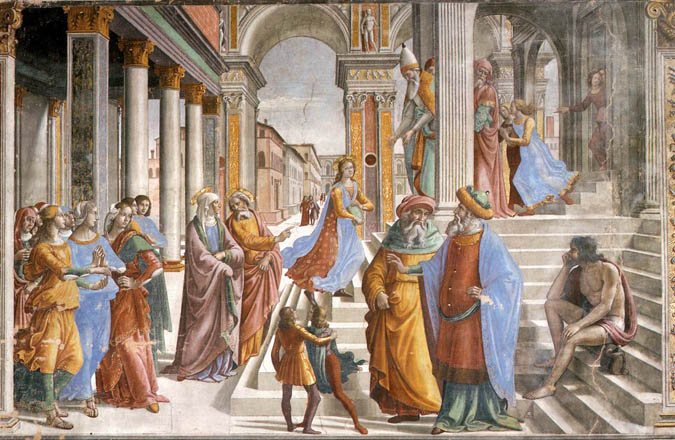
On the second level of the left wall, the Presentation of the Virgin and the Marriage of Mary stand side by side.
With its many separate elements and its complex architecture, the composition of the 'Presentation of the Virgin' is somewhat confused. In the center of the painting, Mary as a girl is hurrying up the steps of the Temple carrying a book, and at the top the venerable high priest is waiting to welcome her with open arms. Her elderly parents have accompanied her to the bottom of the steps. Many old and young witnesses are present. Here too, in the old bearded men and the delicate-featured youths, Ghirlandaio and his assistants undoubtedly portrayed the Florentine nobility who had their houses in that district.
Presentation of the Virgin at the Temple (Detail): 1486-90
Cappella Tornabuoni, Santa Maria Novella, Florence
_1486_90.jpg)
Ghirlandaio was more successful in his depiction of the group of three young women on the left than in his depiction of the main events. In them he demonstrated various body postures and hand movements, and it is possible that here he was inspired by classical reliefs of depicting dancers. The women's classical clothing reflects the colors of Mary's garments and repeats the yellow, blue, red, and green in the garments worn by the old men on the right side.
Presentation of the Virgin at the Temple (Detail): 1486-90
Cappella Tornabuoni, Santa Maria Novella, Florence
_1486_90_Two.jpg)
In the center of the painting, Mary as a girl is hurrying up the steps of the Temple carrying a book. Her elderly parents have accompanied her to the bottom of the steps.
Presentation of the Virgin at the Temple (Detail): 1486-90
Cappella Tornabuoni, Santa Maria Novella, Florence
_1486_90_Three.jpg)
The two old men and the semi-naked figure on the right were used by Ghirlandaio to fill an empty space in the composition. But he used this weakness to present the observer with a successful depiction of a male nude who has nothing to do with the event depicted. The wooden flask on the elegantly lit flight of steps reappears in two panel paintings the artist produced of the 'Adoration' (in the Sassetti Chapel and the Uffizi).
Marriage of Mary: 1486-90
Cappella Tornabuoni, Santa Maria Novella, Florence

On the second level, the 'Presentation of the Virgin' and the 'Marriage of Mary' stand side by side.
In the 'Marriage of Mary' Ghirlandaio shows:
"The youths angrily breaking their rods, which did not flower like that of Joseph. This scene contains many figures and a good building." (Vasari)
In contrast with the 'Presentation of the Virgin', the 'Marriage of Mary' has an entirely symmetrical structure, which is created by an architectural setting that consists of a square space with three barrel vaults along each side. Though the architectural elements are comprehensibly arranged in the picture, the events themselves are not fully integrated with them. It seems as if the architecture and figures were created independently of each other. Looking as though it has been slotted in from above, the architecture does not really look inhabited by the figures. The most remarkable figures are themselves outside the main group, at the edges of the pictorial field; it is thought that the women's figures on the left are most likely to be Ghirlandaio's own work.
Marriage of Mary (Detail): 1486-90
Cappella Tornabuoni, Santa Maria Novella, Florence
_1486_90.jpg)
On the left stand mainly female observers of the ceremony, discussing the event and pointing things out to each other. Two playing girls are running into the picture from the left, their pendent is the boy dressed in blue coming in from the right. His color correspond to that of Mary, and the color of the girls to that of Joseph. Ghirlandaio has here created a balanced composition based on color and symmetry.
Marriage of Mary (Detail): 1486-90
Cappella Tornabuoni, Santa Maria Novella, Florence
_1486_90_Two.jpg)
The men whose rods did not blossom forth as Joseph's did, are breaking their rods in anger and one of them is shaking his fist. They are disappointed that old Joseph of all people should have been chosen instead of them to marry the Virgin. A different mood is created by the laughing faces behind the groom, as well as the musicians with drums and pipes, who are starting up the music for the celebrations.
Adoration of the Magi: 1486-90
Cappella Tornabuoni, Santa Maria Novella, Florence
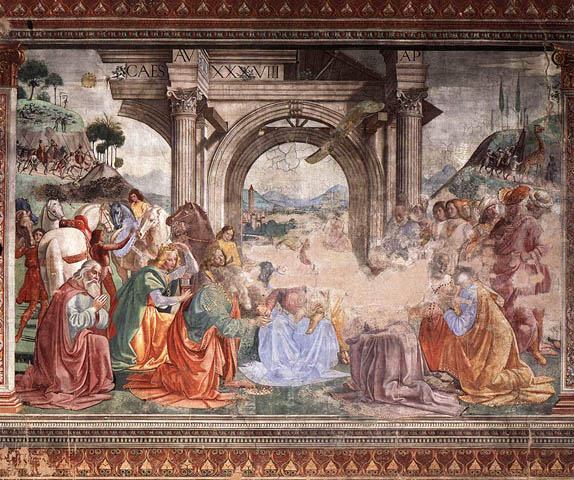
The 'Adoration of the Magi' is on the third level of the left wall of the chapel. It is next to the equally large fresco the 'Slaughter of the Innocents'.
"The fifth shows the coming of the Magi to Bethlehem with a number of men, horses, dromedaries and other things, a very well-arranged scene". (Vasari)
This scene, which has been severely damaged by damp, shows Mary and the Child in the center with an arch above them. The latter is part of the ruins of a classical triumphal arch, such as Ghirlandaio had seen in Rome. The youngest king on the left is reverently removing his crown and is about to kneel and present his gift to the child. In the background is the king's retinue, which even includes a giraffe.
The fresco is shown before the recent restoration.
Adoration of the Magi (Detail): 1486-90
Cappella Tornabuoni, Santa Maria Novella, Florence
_1486_90.jpg)
The youngest king on the left is reverently removing his crown and is about to kneel and present his gift to the child.
Slaughter of the Innocents: 1486-90
Cappella Tornabuoni, Santa Maria Novella, Florence
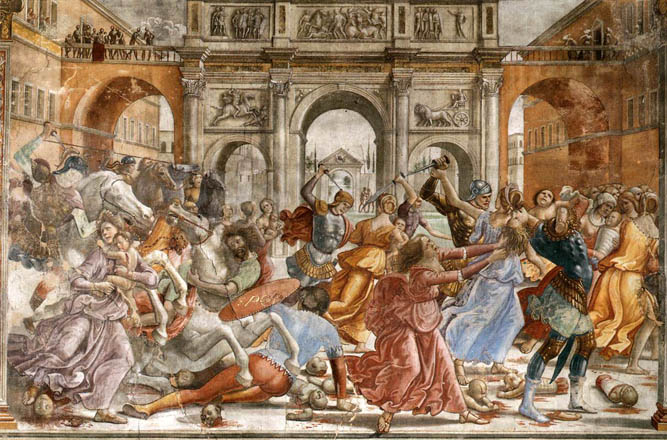
The 'Slaughter of the Innocents' is on the third level of the left wall of the chapel, next to the 'Adoration of the Magi'.
Vasari described this scene as being the best painting in the entire cycle "because it was executed with good judgment, ingenuity, and great skill". In the fresco "... we see the cruelty of those who at Herod's command kill the poor children without pity for their mothers... Many other emotions are also represented, so that no beholder can doubt the excellence of the master".
It is surprising that this horrific event is given an individual monumental scene in the cycle of the life of Mary, and that the normally very popular Annunciation scene is pushed to one side. But the 'Slaughter of the Innocents' provided Ghirlandaio with an opportunity to present a dramatic composition showing a lively crowd scene scenes he had studied in classical models. It was not without reason that he placed a Roman triumphal arch covered with relief of classical battle scenes towering up behind the dramatic events. Once again the background of the picture acts as a backdrop, for the figures are bunched together on a densely packed front stage and are not integrated into architecture. The Slaughter of the Innocents takes place amid a violent swirl of movements and gestures. There is a dramatic confusion of people's and horses' bodies, which fall upon each other all around. Ghirlandaio depicts the classical model for the scene at the top on the arch.
The liveliest composition in the artist's entire range of works, this large crowd scene is reminiscent of classical battle reliefs. The mothers of Bethlehem are in a wild panic, trying to save their children from the killers' swords, which are flashing through the air. On the ground lie the mutilated bodies of the slaughtered innocents in pools of blood.
In the foreground on the right a desperately screaming mother, her red garment billowing in frantic folds, is tearing at the hair of one of the killers from behind. Pure horror is written on her face. The soldier, dressed in classical armor that has a blue leather body piece shaped to indicated the ribs, is bending right over backwards. The foreground of the picture is characterized by falling horses, bloody limbs and heads, streaming hair and drawn swords. On the far right the fleeing mothers are bunched together, but they will not succeed in escaping Herod's order that all the children of the same age as Christ should be put to the sword.
Death and Assumption of the Virgin: 1486-90
Cappella Tornabuoni, Santa Maria Novella, Florence
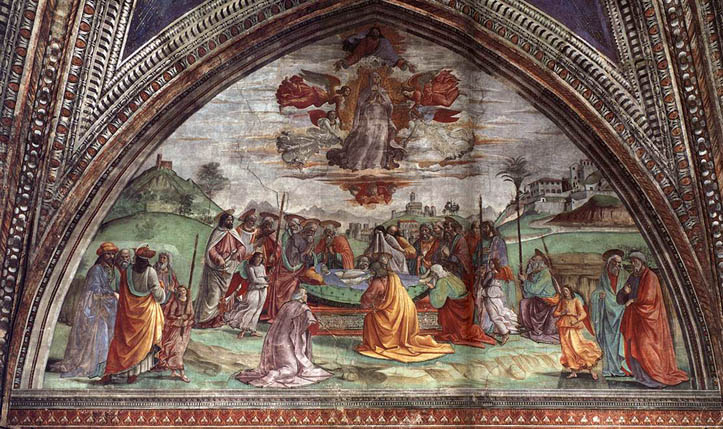
In the final scene, painted in the large pointed tympanum on the left wall of the chapel, two events, the 'Death and Assumption of the Virgin', are depicted in one picture.
In this last story "... is the Passing of Our Lady and her Assumption, with troops of angels, a number of figures, landscapes and other ornaments, in which Domenico's easy and skilful style usually abounds". (Vasari)
The composition and execution of this poorly preserved fresco are poorer than in the other pictures in the chapel. In its solemn character the scene is comparable with the considerably better Obsequies in the Saint Fina and the Sassetti chapels. Mary's body is lying on a bier in an open space, mourned by the grieving Apostles. Four angels are carrying long candles or palm leaves. The dead Mary's pale face is old, her cheeks sunken. But in a glory above her, a young and beautiful Virgin with a rosy face is being carried up to heaven by angels to meet her son.
Frescoes on the Right Wall: Stories of Saint John the Baptist
The fresco cycle on the right wall consists of seven scenes (from bottom up):
(1) Angel Appearing to Zacharias
(2) Visitation
(3) Birth of St John the Baptist
(4) Zacharias Writes Down the Name of his Son
(5) Preaching of St John the Baptist
(6) Baptism of Christ
(7) Herod's Banquet.
Angel Appearing to Zacharias: 1486-90
Cappella Tornabuoni, Santa Maria Novella, Florence
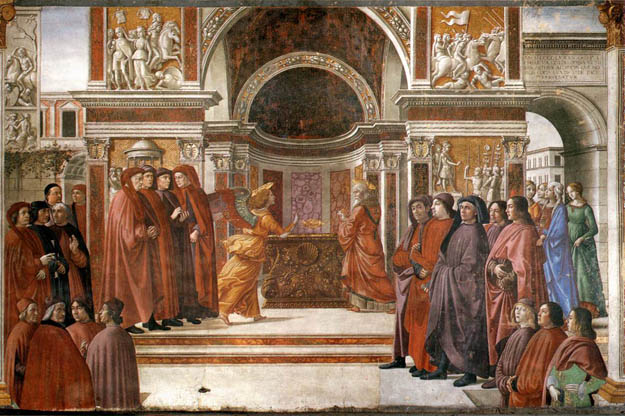
The first scene of the stories of Saint John the Baptist, the 'Angel Appearing to Zacharias' is represented at the bottom on the right wall.
Vasari wrote: "Domenico introduced a goodly number of Florentine citizens, who were then members of the Government, and especially all the members of the Tornabuoni family".
In this fresco Ghirlandaio portrayed a considerable number of contemporary political figures and members of the donor families - such as Giuliano, Gian Francesco and Giovanni Battista Tornabuoni on the right, together with Giovanni Tornaquinci. Those portrayed are not taking part in the biblical events; rather, it seems important to them to be seen in this context. The artist arranges them in groups of three, four and five figures on various ground levels, so that they do not overlap too much. As a result, the front groups are standing at the edges of the picture in rather absurd holes - an artistic device that Ghirlandaio employed with considerably more skill in the Sassetti Chapel by making the figures climb a flight of steps. It is likely that the artist had to accede to the wishes of his client and incorporate all these figures, relatives and friends, into the scene. In the process he once again showed himself to be a superb portrait painter with the talent to create character studies with a psychological profundity.
Angel Appearing to Zacharias (Detail): 1486-90
Cappella Tornabuoni, Santa Maria Novella, Florence
_1486_90.jpg)
The detail shows various members of the Tornabuoni and Tornaquinci families. Giuliano Tornabuoni, Giovanni Tornaquinci and Gian Francesco Tornabuoni are standing on the right, posing in front of the painter; on the left is another Tornabuoni, Giovanni Battista.
Some women are standing a little to one side underneath a tympanum on which are written words celebrating the happy period in which this chapel was completed. The words are those of Agnolo Poliziano: "In the year of 1490, when the brilliant city, famed for its wealth, history, vitality and its architecture, was living in peace and prosperity." Above the heads of the men, the artist depicts a classical relief, on a background of golden mosaic, that depicts a military commander addressing his soldiers. The same motif is depicted in grisaille in the Sassetti Chapel.
Angel Appearing to Zacharias (Detail): 1486-90
Cappella Tornabuoni, Santa Maria Novella, Florence
_1486_90_Two.jpg)
On the left is the fine world of contemporary Florentine culture.
"These were the most learned Florentines of the day, namely Marsilio Ficino in a canon's dress; Cristofano Landino next, in a red mantle and a black ribbon round his throat; Demetrius the Greek in the middle, turning round and lifting his hand slightly; Angelo Poliziano, all full of life and energy". (Vasari)
Angel Appearing to Zacharias (Detail): 1486-90
_1486_90_Three.jpg)
This series of portraits of contemporary Neo-Platonists, their heads all at the same level, continues the row of classical heads in the relief behind them - this is Ghirlandaio's way of presenting Neo-Platonists as a continuation of the classical intellectual tradition.
Visitation: 1486-90
Cappella Tornabuoni, Santa Maria Novella, Florence
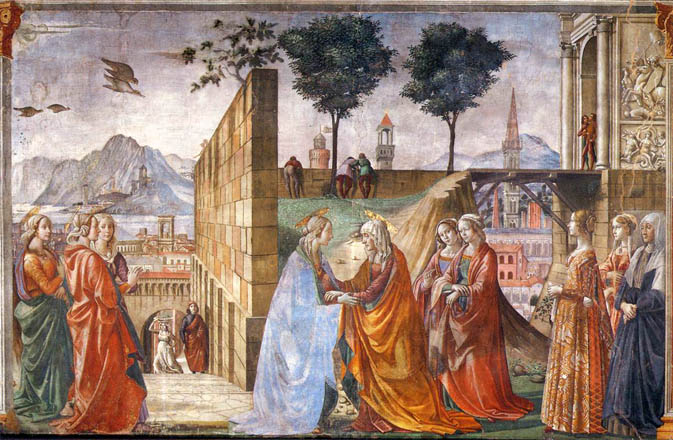
The right wall in the Tornabuoni Chapel tells the story of 'Saint John the Baptist' in the same seven picture areas as the story of Mary is told on the wall opposite. The two stories meet in the fresco the 'Visitation', in which the two mothers-to-be, the young Mary and the aged Elizabeth are depicted.
The 'Visitation' is the second scene in the lower section of the right wall. "The Visitation of Our Lady and Saint Elizabeth, accompanied by women wearing the costumes of the day". (Vasari)
Along with the two birth scenes, the 'Visitation' is one of the most important pictures in the entire chapel. The meeting of the Virgin Mary and Saint Elizabeth in the center was painted quickly and easily. Ghirlandaio then uses the remaining space to display a little of everything that his brush is capable of producing and that his donor stipulated in the contract: landscape and cities, animals and plants, a bold use of perspective, classical buildings and reliefs and, not least, portraits of noble and beautiful women.
Various women spectators are witness to the event. Among them Vasari identifies: "Ginevra de' Benci, a most beautiful girl".
The person he refers to is standing on the right, though it is much more probable that she is actually Giovanna degli Albizzi, who in those very years became the wife of Lorenzo Tornabuoni.
In the background of the visitation, side by side, are features that reflect the two sources of Ghirlandaio's pictorial inspiration: classical art and Flemish painting. On the right, the classical era is represented by a building with sculptural decorations, while the men seen from behind, leaning over wall, are derived from superb Flemish paintings - Jan van Eyck painted such figures in the background of his so-called Rolin Madonna about 1436 (now in the Musée du Louvre), and Rogier van der Weyden created a variation on this idea in his Saint Luke Painting the Virgin (now in Boston). Ghirlandaio uses the classical reliefs and the strong horizontal line of the wall below them to establish a link with the next scene, the 'Angel Appearing to Zacharias'.
Visitation (Detail): 1486-90
Cappella Tornabuoni, Santa Maria Novella, Florence
_1486_90.jpg)
The detail shows the measured and affectionate embrace between the two women, a demonstration of mutual respect. A pair of women behind them are Elizabeth's companions.
Giovanna degli Albizzi is the third figure from right.
Visitation (Detail): 1486-90
Cappella Tornabuoni, Santa Maria Novella, Florence
_1486_90_Two.jpg)
Ghirlandaio created a bold but convincing spatial situation in this detail of the visitation: a wall that follows converging lines of perspective conveys a vivid sense of spatial depth. On the left a paved road leads through a gateway into the lower part of the city by the waterside; hurrying up the road is a servant carrying a bowl on her head, a figure reminiscent of the servant in the 'Birth of Saint John'. Behind the two central figures, Mary and Elizabeth, a sandy path leads up to the wall. The group of women on the left, so typical of Ghirlandaio, is a variation of a single type seen from different points of view.
Visitation (Detail): 1486-90
Cappella Tornabuoni, Santa Maria Novella, Florence
_1486_90_Three.jpg)
In this detail Giovanna Albizzi-Tornabuoni is standing directly underneath the arch of a classical triumphal archway flanked by columns, just as if she were the main figure in the painting. In 1486 she married Lorenzo, the son of the donor. Vasari mistakenly thought she was "Ginevra de' Benci, a most beautiful young girl living at the time", whose portrait was painted by Leonardo da Vinci about 1478. Giovanna, who is standing stiff and rigid, is shown in sharp profile, wearing a magnificent gleaming gown and has an elegant hairstyle, unapproachable in front of her companions.
The two figures stepping out through the classical gateway make it clear just how monumentally large, and how far away, the building behind them is.
Visitation (Detail): 1486-90
Cappella Tornabuoni, Santa Maria Novella, Florence
_1486_90_Four.jpg)
In the background three men are leaning over the wall and watching the activity in the city below, activities we cannot see. The tower between the two trees is very similar to that of Florence's Palazzo Vecchio. Two figures stepping out through the classical gateway make it clear just how monumentally large, and how far away, the building behind them is.
Birth of Saint John the Baptist: 1486-90
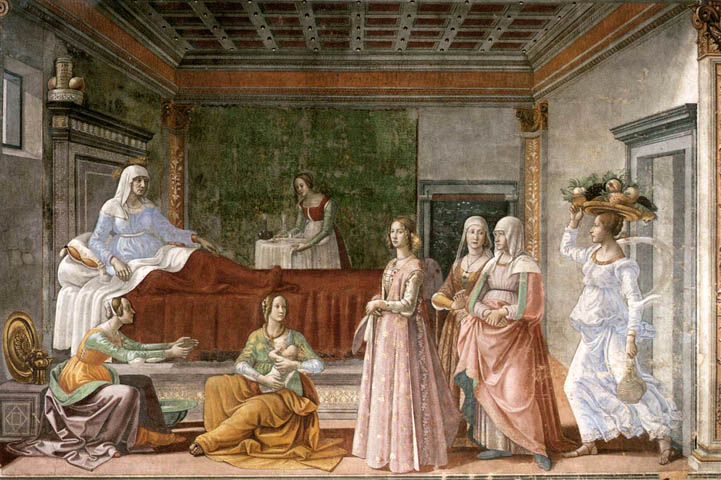
The Birth of Saint John the Baptist and the Zacharias Writes Down the Name of his Son can be found on the second level of the right wall.
The scene is described by Vasari. "The Birth of Saint John, with a beautiful idea that, while Elizabeth is in bed and being visited by her neighbors and a nurse is suckling the child, a woman is eagerly calling the attention of the visitors to the wonder that has come to her mistress in her old age; and lastly there is a woman bringing fruit and wine from the city, in conformity with the Florentine custom. This is very fine".
In the Birth of Saint John the Baptist Ghirlandaio once again created a room flooded with light and air. We can well imagine that the palace rooms of Ghirlandaio's patrons being similar to this. In this picture he makes use of contrasting complementary colors by placing the red bedspread in front of the green wall hanging. In front of the wall hanging, a maid dressed in red and green is carrying a tray with carafes of water and wine for the refreshment of the woman in childbed. The golden orange hues of the pilasters and entablatures form a complementary contrast with the light blue of aged Elizabeth and the young maid coming in from at the far right. Such color schemes help to create the captivating clarity that characterizes so much of Ghirlandaio's work.
It is not just the age of Elizabeth and her maid that contrast, but also their respective auras of stillness and movement. Nowadays it is astonishing to think that Savonarola, the severe preacher of repentance, could have taken exception to this superb maid. She corresponds to the nurse on the far left, who is stretching out her arms eagerly. The two figures form an exciting frame for the quiet scene taking place in-between.
In the 'Birth of John the Baptist', Elizabeth is visited by female representatives of the donor family - as is Anne in the birth scene on the opposite wall. The only figure that can be identified is that of the poet Lucrezia Tornabuoni, who was known for being very virtuous. She was the mother of Lorenzo de' Medici and a friend of the humanist Agnolo Poliziano and Luigi Pulci, portrayed in the Sassetti Chapel together with her son.
There is actually nothing in this scene to suggest that it is depicting an event from the story of Saint John - with the sole exception of the severely weather-beaten halo surrounding Elizabeth's head. In this scene from everyday life, Ghirlandaio surpassed even his beautiful Birth of Mary. In addition to the marvelous basket of fruit, he added another two still-lifes to the picture in order to make it appear more home-like and realistic. On the far left two objects, a brass jug and bowl, that we are already familiar with from the fresco the 'Last Supper' in the church of Ognissanti, and from the frescoes in the Santa Fina Chapel. At the top of the bed's headboard, next to the window, there is a symmetrical arrangement of a box, two pomegranates and a vase, reminiscent of both Saint Jerome's study and the frescoes in the Saint Fina Chapel. All these things once again bring Flemish painting to mind, which during this period made widespread use of everyday secular details as accessories. The miniature depicting the birth of Saint John the Baptist in the Turin/Milan Book of Hours is an outstanding example - a superb work that was most probably painted by Jan van Eyck himself, though its attribution is just as disputed as its date.
Birth of Saint John the Baptist (Detail): 1486-90
Cappella Tornabuoni, Santa Maria Novella, Florence
_1486_90.jpg)
The small Saint John is being breast fed by a young nurse in the foreground, and a servant is already stretching her arms out energetically for him, in order to give the newborn a bath in a green bowl. Behind them, Ghirlandaio has clearly shown the position the mother is lying in under the blankets. Her bed is made the same way that beds are made in Italy to this day - a white linen sheet turned down at the top end over a woolen blanket.
Birth of Saint John the Baptist (Detail): 1486-90
Cappella Tornabuoni, Santa Maria Novella, Florence
_1486_90_Two.jpg)
Here a beautiful unknown woman from the donor's immediate circle is looking at us. She is holding a small cloth in her hands, which are elegantly clasped in front of her stomach, and dressed in a gentle pink, a hue picked up in her cheeks. Two women wearing white head-dresses accompany her; the elder is probably the donor's sister, Lucrezia Tornabuoni, who died before the picture was painted. She was the mother of Lorenzo il Magnifico and sister of Giovanni.
Birth of Saint John the Baptist (Detail): 1486-90
Cappella Tornabuoni, Santa Maria Novella, Florence
_1486_90_Three.jpg)
The last figure on the right, obviously a maid carrying gifts, is quite agitated, which contrasts with the play of folds and veils in the composed procession of the others. Hers is almost a dance step, and one might well ask why. It could be a deliberate reference to Ghirlandaio's immediate predecessor Filippo Lippi or even some more lively Botticellian inspiration, though it does seem rather forced and somewhat disharmonious in the midst of such calm.
Zacharias Writes Down the Name of his Son: 1486-90
Cappella Tornabuoni, Santa Maria Novella, Florence
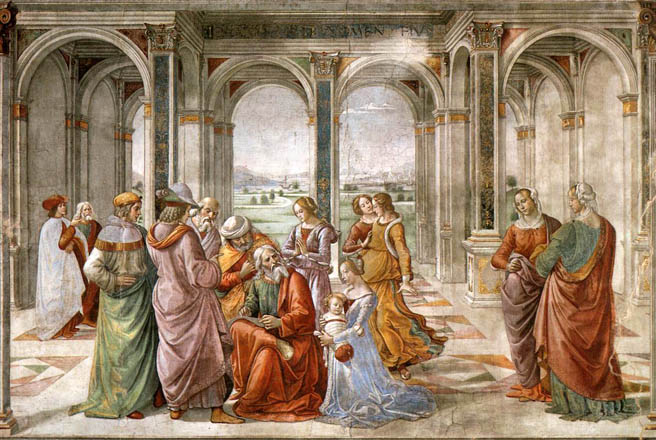
Ghirlandaio has made this composition animated by the unusual device of placing the most important group of people, who are standing around Zacharias, off center. This means that the baby John is in the centre directly under the middle pilaster. The open loggia architecture with a view onto a landscape in the background is not connected with the events in the picture. It is possible that it was added, as a backdrop, late in the production of the work.
Ghirlandaio places the seated priest Zacharias in front of a magnificent loggia which opens out onto an extensive landscape. Vasari writes how Zacharias, "whose spirit is undaunted although he is still mute, expresses amazement that a son has been born to him, and while they ask him what name to give his son, he writes on his knees - all the while staring at his son, who is held by a woman kneeling reverently before him - forming with a pen on paper the words 'His name will be John', to the astonishment of many of the other figures, who seem to be wondering whether this could be true or not."
There exists a preparatory drawing for the scene showing Saint John's naming, in which the two secondary female figures on the far right were sketched. Neither of them play a part in the narrative, but guide us via the figure seen from behind on the right, where this scene borders the birth scene, into the pictorial fields and, by means of the direction they are gazing in, draw the attention of the picture's observer to the central event taking place, the naming. At the same time, the two women exist as independent optical sensations. They decorate the pictorial field like a frame, a harmonious group that is pleasant to look at. Ghirlandaio drew the same young woman seen from two different points of view, from the front and behind, just as they then appeared on the fresco.
Zacharias Writes Down the Name of his Son (Detail): 1486-90
Cappella Tornabuoni, Santa Maria Novella, Florence
_1486_90.jpg)
The bathed and swaddled baby John has been carried by a young maid across to his old father, Zacharias, who is forced to write down the name of his son as at the annunciation the angel struck him dumb until the birth of his son. Old men are leaning forward in order to read the name. The extensive landscape in the background shows a town with a harbor in which a ship at anchor is clearly visible. In accordance with the laws of aerial perspective, the colors in the distance become paler and lighter.
Zacharias Writes Down the Name of his Son (Detail): 1486-90
Cappella Tornabuoni, Santa Maria Novella, Florence
_1486_90_Two.jpg)
The two women standing to one side on the right are part of Ghirlandaio's typical wealth of figures. They are less "stopgaps" to balance the composition than an opportunity for Ghirlandaio to present variations on the theme of "standing female figure". He carefully prepared these robed figures in a preparatory study.
Preaching of Saint John the Baptist: 1486-90
Cappella Tornabuoni, Santa Maria Novella, Florence
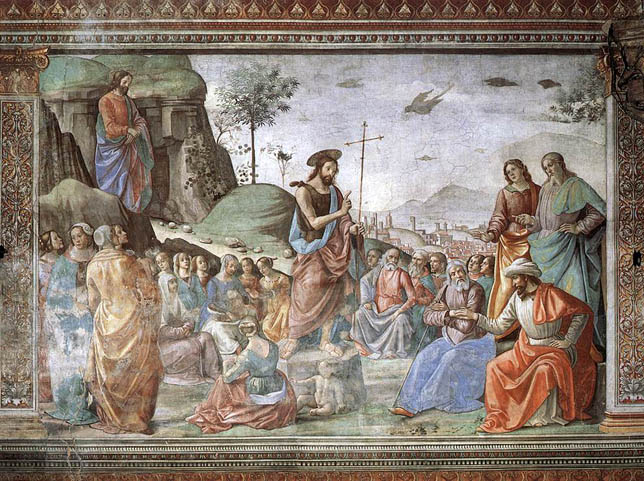
On the third level there are two frescoes, side by side, that deal with the mission of Saint John the Baptist. In the picture on the right he is preaching, and in the next picture he is baptizing Christ. The same landscape is continued through both scenes, linking them to one another.
The fifth scene of the cycle depicts the Preaching of Saint John the Baptist. "The fifth contains the preaching to the multitudes showing the attention of the people in hearing new things." (Vasari)
While Saint John in a fur robe is making didactic gestures and preaching about the coming of the Messiah to an intent group of listeners, Christ is already approaching. Unnoticed by the Baptist, who is pointing to his cross staff, Christ is stepping out of the background into the scene between the rocks.
Worthy of note in the preaching scene, and typical of Ghirlandaio, is the group of women on the left, with a beautiful figure seen from behind. Another figure seen from behind is seated at the feet of the preaching Saint John. The naked sitting child is Ghirlandaio's quotation of classical sculpture.
Baptism of Christ: 1486-90
Cappella Tornabuoni, Santa Maria Novella, Florence

On the third level there are two frescoes, side by side, that deal with the mission of Saint John the Baptist. In the picture on the right he is preaching, and in the next picture he is baptizing Christ. The same landscape is continued through both scenes, linking them to one another.
The sixth scene of the cycle depicts the Baptism of Christ. This story shows, "His reverential attitude displaying the belief which he had in that sacrament, and... he represented a crowd of naked and bare-footed figures waiting to be baptized, their faces displaying faith and desire, one especially who is taking off his shoe being energy itself". (Vasari)
The Baptism of Christ is an emulation of the painting by Verrocchio and Leonardo in the Uffizi, though the angels and landscape are far weaker. There is a very old-fashioned feeling about the depiction of God the Father, who is giving His blessing surrounded by angels.
In this painting the artist was interested less in depicting the baptism than in displaying variation of the nude figure. These were inspired both by Masaccio's frescoes in the Brancacci Chapel and also by classical sculpture. As early as the 1440's, in Piero della Francesca's Baptism of Christ, a magnificent nude figure had been depicted in the act of undressing. Piero's arrangement of the main figures also influenced of the version of the Baptism by Verrocchio and Leonardo.
Baptism of Christ (Detail): 1486-90
Cappella Tornabuoni, Santa Maria Novella, Florence
_1486_90.jpg)
The strict composition is based on a design that is reminiscent of the early work in Sant' Andrea a Bozzi and derives from Verrocchio's famous Baptism of Christ. in the Uffizi. Ghirlandaio made slight changes to Christ's standing position and replaced the angels on the right with a kneeling male nude, who is already taking off his shoes in preparation for the baptismal ceremony. On the left we can see, from behind, another naked man about to be baptized.
Herod's Banquet: 1486-90
Cappella Tornabuoni, Santa Maria Novella, Florence
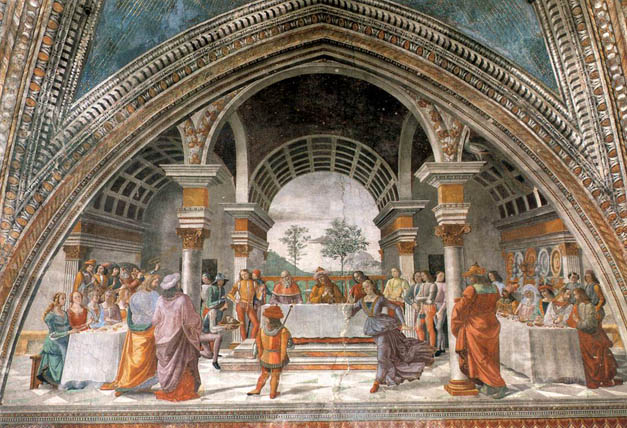
The cycle of the life of Saint John concludes in the large tympanum with Herod's Banquet, about which Vasari wrote that: "The last scene, the one in the arch next to the vaulting, presents the sumptuous Banquet of Herod and the Dance of Herodias, along with countless servants performing various chores in the scene ; the picture also contains a large building drawn in perspective which, together with the painted figures, clearly reveals Domenico's skill."
A colossal palace architecture, carefully constructed according to the laws of perspective, rises up in the form of a series of enormous barrel and dome vaults, which in the foreground are supported by columns. Ghirlandaio was familiar with these columns with entablature blocks from Brunelleschi's Florentine churches of Santo Spirito and San Lorenzo, while the complex overall design of the building is reminiscent of the Maxentius Basilica in Rome. That classical building had been built by the Roman Emperors Maxentius and Constantine as a monumental hall building with three aisles; the long central aisle was roofed by three huge groin vaults and the side aisles by coffered vaults.
In contrast to his more restrained depiction of Mary's death, here Ghirlandaio uses his powers to the full, both in the extravagant architecture and the vivid, though still somewhat stiff, figure of the dancing Salome. Ghirlandaio adopted and varied this dancing figure, together with the entire composition of the scene, from Filippo Lippi's depiction of the same scene in Prato Cathedral, painted between 1452 and 1466. That earlier painting already contains the musicians on the left, the row of pots on the right and the view out onto a landscape in the center. The arrangement of the figures was altered, but scarcely improved, by Ghirlandaio. Above all, and in the face of the festive and yet gruesome events, the figures lack all sense of drama. They display neither a lively party mood nor signs of horror or repulsion. The arrangement of the banqueters around the three long laid tables is reminiscent of Ghirlandaio's earlier depictions of the Last Supper. Here too, in addition to wine glasses and bowls, red cherries are arranged on the white table cloth.
Herod's Banquet (Detail): 1486-90
Cappella Tornabuoni, Santa Maria Novella, Florence
_1486_90.jpg)
The beautiful Salome in the bluish shining dress is dancing in so animatedly that her dress is flapping behind her. Her moving arms are bent in an impetuous but still gracious manner. The vision bewitched King Herod to such a degree that he promised to fulfill her every desire. She then requested the cut off head of Saint John the Baptist, and this is already being presented to the banqueters on a platter on the left side of the fresco.
Frescoes on the Rear Wall and Vaults
Portrait of the Donor Giovanni Tornabuoni: 1486-90
Cappella Tornabuoni, Santa Maria Novella, Florence
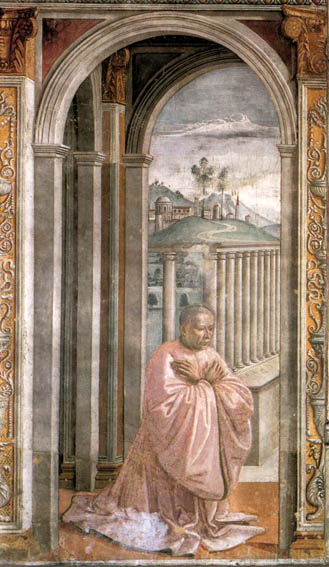
The two portraits of the praying patrons, Giovanni Tornabuoni and Francesca Pitti, are at the sides of the main altar. Their poses are similar to those of Francesco Sassetti and Nera Corsi, but their appearance and the setting are quite different.
His arms folded humbly across his chest, the rich banker is kneeling under arches that open onto a landscape. The landscape and architecture, shown in correct perspective, continue in the corresponding portrait of his wife. The row of columns behind him gives the painting a great sense of depth.
Portrait of the Donor Francesca Pitti-Tornabuoni: 1486-90
Cappella Tornabuoni, Santa Maria Novella, Florence
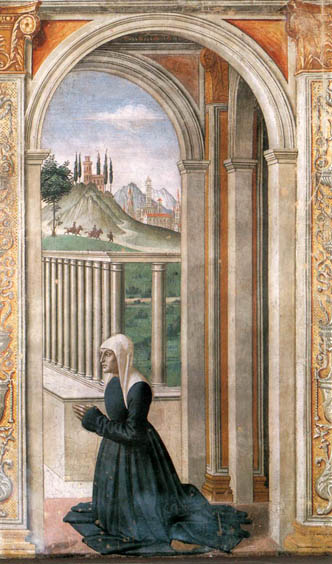
The Donor's wife is kneeling in prayer on the right side, opposite her husband. By the time the fresco was created she had been dead for some years. It is possible that the pallor of her face indicates this
Annunciation: 1486-90
Cappella Tornabuoni, Santa Maria Novella, Florence
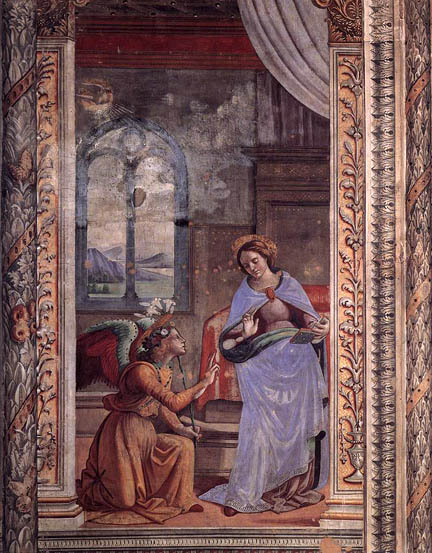
At the height of the 'Presentation of the Virgin' and the 'Marriage of Mary' - above the corner of the chapel and connecting with the rear wall next to the Gothic window - there is the narrow fresco the 'Annunciation'.
Again Ghirlandaio has moved the scene of this Biblical event to Tuscany and his own era. He was able to find the traditional Renaissance form of a painted window with a view of a landscape in many Florentine palaces. They can still be seen today in Florence, examples being the palaces of the Medici, Ruccelai and Strozzi families. The angel is derived from the 'Annunciation' painted by the young Leonardo da Vinci between 1472 and 1475, now on view in the Galleria degli Uffizi.
In contrast to Leonardo's horizontal format, in Ghirlandaio's fresco in the predetermined vertical format his 'Virgin' may be depicted facing the observer in an equally frontal view, but she is standing upright. She is therefore reminiscent of the beautiful picture on the same theme by Lorenzo di Credi, an artist who was also taught by Verrocchio together with Leonardo and Ghirlandaio.
Saint John the Baptist in the Desert: 1486-90
Cappella Tornabuoni, Santa Maria Novella, Florence
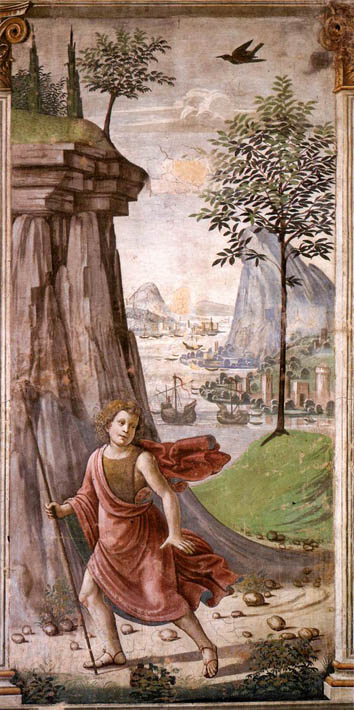
Ghirlandaio's workshop produced three panel paintings to form part of the overall decoration of the Tornabuoni Chapel: on the rear wall, and the front and back panels of the main altarpiece. That on the rear wall, described by Vasari as "Our Lady who appears with the Child in celestial glory together with the archangel Michael and Saint John the Baptist, and at the sides Saint Catherine of Siena and Saint Laurence dressed as Deacon" was lost in the careless restoration of 1804, but the frescoes which framed it with the Stories of Saint Peter Martyr have survived. The execution of Saint John is not depicted in the Tornabuoni Chapel. In its place, however, is the fresco on the window wall showing the martyrdom of the Dominican Saint Peter Martyr. Perhaps the intention was to equate the Dominican saint with John the Baptist. This fresco was probably executed by David and Benedetto Ghirlandaio.
Also survived the Saint John in the Desert, one of the most famous frescoes, which was by tradition attributed to the young Michelangelo. Many writers believe the young Michelangelo carried out some of the work in these poorer paintings by Ghirlandaio's workshop. They even believe that a narrow fresco on the window wall may contain a portrait of the barely fifteen year old artist, who is thought to have worked as an assistant in the Tornabuoni Chapel.
When he was a boy, Saint John went into the desert in order to do penance. He is depicted moving quickly, his cloak flapping behind him. He turns once more towards his parents, who he is now leaving. In the background, ocean-going ships are anchored in front of a town.
Saint Matthew the Evangelist: 1486-90
Cappella Tornabuoni, Santa Maria Novella, Florence

In the Gothic vaults of the Tornabuoni Chapel the four Evangelists are floating on clouds.
Saint Matthew the Evangelist is holding the slate pencil in the fingertips of his right hand, and with his left hand he is holding out an open book for us to see. As he does so, he is looking attentively at his symbol, the little angel. The latter, wearing a fluttering garment, comes very close to the Evangelist in order to convey to him the word of God.
Saint Mark the Evangelist: 1486-90
Cappella Tornabuoni, Santa Maria Novella, Florence
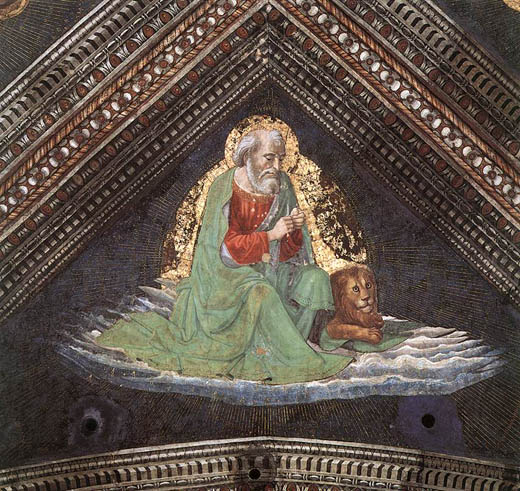
In the Gothic vaults of the Tornabuoni Chapel the four Evangelists are floating on clouds.
Saint Mark the Evangelist is concentrating on sharpening his quill with a knife. The lion at his feet, his symbolic animal, is looking into the chapel with his large eyes.
Saint Luke the Evangelist: 1486-90
Cappella Tornabuoni, Santa Maria Novella, Florence
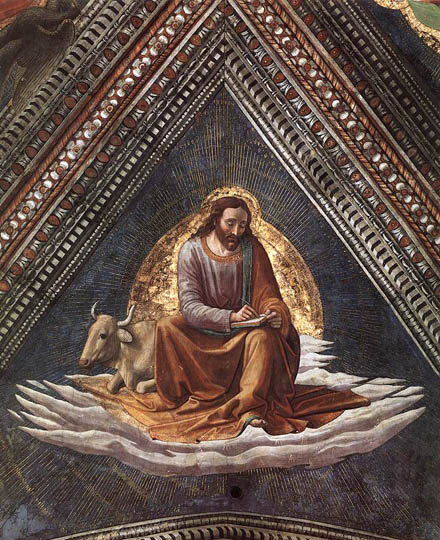
In the Gothic vaults of the Tornabuoni Chapel the four Evangelists are floating on clouds.
Saint Luke the Evangelist, depicted as a young man with brown hair and a beard, is looking at a little book on his knee as he writes down the life of Christ. On his left a very realistic ox, the Evangelist's symbol, is resting. The reflections in its large black eye make it look quite good-natured.
Saint John the Evangelist: 1486-90
Cappella Tornabuoni, Santa Maria Novella, Florence

In the Gothic vaults of the Tornabuoni Chapel the four Evangelists are floating on clouds.
Saint John the Evangelist is writing down God's words, which are being conveyed to him by his symbolic animal, the eagle, on a piece of paper.
Apotheosis of Saint Zenobius in the Palazzo Vecchio, Florence
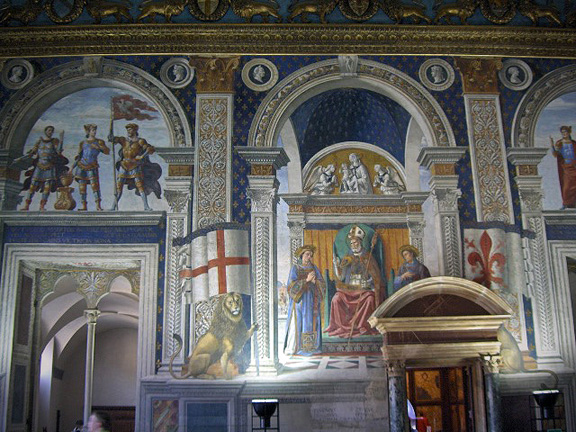
Panel Paintings
Numerous works on wood complete the career of Ghirlandaio, who was known above all as a fresco painter. They are works which again emphasize his abilities as a colorist, the harmonious pleasantness of his composition, and his faithfulness to certain models of his time and his school.
Ghirlandaio's greatest achievement was the decoration of mainly private chapels with monumental frescoes. That was what he was famous for and why he was in demand. But the furnishings of a chapel also included an altarpiece, and normally this would consist of an altar painting. The altarpieces normally found in Gothic art, consisting of several individual panels, with images painted on a gold background, had largely disappeared by Ghirlandaio's time. A new type of altarpiece had become common: the square panel. Though many of Ghirlandaio's motifs were influenced by Flemish panel paintings, he did not adopt their new technique of painting with oils, but continued to work predominantly with tempera throughout his life. The commission for the Sassetti Chapel in Santa Trinità included a panel painting for the altar of the chapel, while that for the Tornabuoni Chapel a panel painting for the main altar in the church of Santa Maria Novella - the Pala Tornabuoni - and its rear panel facing the apsidal chapel. The altarpiece with the 'Adoration of the Shepherds' from above the altar in the Sassetti Chapel can still be worshipped in its original location, but the ensemble in the Tornabuoni Chapel was dismembered in 1816. The main altar painting is now in Munich, while the rear panel, the 'Resurrection of Christ' is now in Berlin. Another important panel painting, the 'Adoration of the Magi' in the Spedale degli Innocenti, Florence is displayed on separate pages this Gallery.
Madonna and Child Enthroned with Saints: ca 1479
Duomo San Martino, Lucca
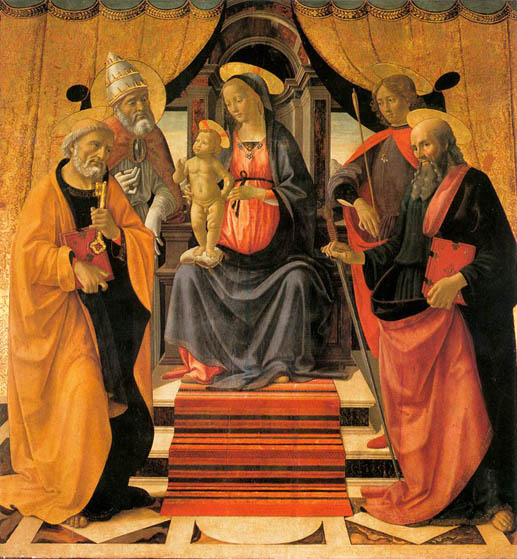
A curtain of gold brocade is drawn to one side, making it possible for us to see the enthroned Madonna and the Christ Child. Held gently by his mother, Christ is standing upright on a cushion. His left hand casually resting on his hip, his right hand raised in blessing. Saint Peter and Pope Clement are on the left of the throne, Saint Paul and Saint Sebastian on the right.
The motif of Christ Child, shown naked, seen from a frontal view standing on his mother's right thigh, was borrowed from Verrocchio.
Madonna and Child Enthroned with Saints: ca 1483
Galleria degli Uffizi, Florence
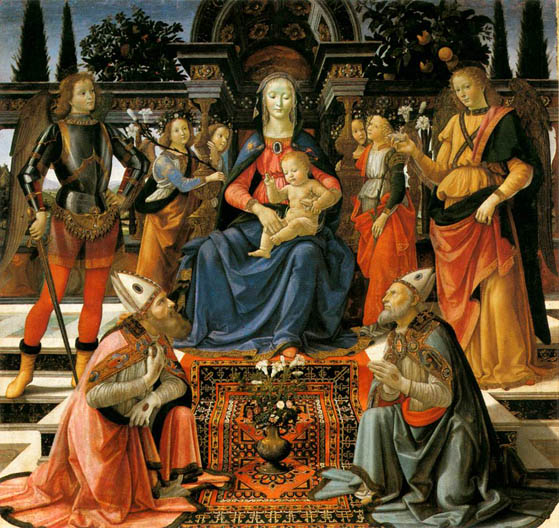
The painting depicting the Madonna enthroned with Saints was painted for the church of San Giusto.
Altar paintings depicting the Virgin Mary and Christ together with several saints were common in Ghirlandaio's day. In Renaissance Italy, Enthroned Madonnas, surrounded by saints, were extremely popular. In such a picture, which was called a Sacra Conversazione, or "holy conversation", it was possible to combine various saints in accordance with the requirements of the individual donors and church representatives. The donor's patron saint would, for example, be depicted next to the main patron saint of the church or altar, or the founder of an order. It is frequently possible to tell, by looking at the depicted saints, which church a painting was in and to which order the church belonged. The choice of saints could in effect be extended to include, for example, the patron saints of a town or guild.
Two such works by Ghirlandaio are now in the Galleria degli Uffizi in Florence . In both pictures the Christ Child is depicted in a similar posture, his hand raised in blessing. In the earlier painting with the tied back curtain, in Lucca Cathedral, Ghirlandaio depicted all the saints in a standing position. But in the later works the two saints at the front are kneeling. This makes a better use of the surface of the picture and at the same time achieves a more interesting arrangement of figures by creating a pyramidal composition formed by the kneeling saints and the Madonna. The panels in the Uffizi are filled with decorative accessories, such as the carpets on the steps leading up to the throne and the flower vases, and these were surely influenced by Flemish works. The depictions of the Madonna are, however, still in keeping with Verrocchio's models.
The picture is composed in a strictly symmetrical manner. The archangel Michael in shining armor is similar to Saint Julian in Ghirlandaio's earliest Sacra Conversazione in Sant' Andrea a Brozzi. The trees are a quotation of the Last Supper in Ognissanti, and the carpet is similar to the table covering in the Ognissanti Sant Jerome.
Madonna and Child Enthroned with Saints (Detail): ca 1483
Galleria degli Uffizi, Florence
_ca_1483.jpg)
This detail of a flower vase on a colorful carpet could be taken from a Flemish panel painting if it were painted using the oil technique developed there rather than tempera, which Ghirlandaio used. In this detail, the artist creates a positive frenzy of colors and forms to enliven the picture.
Coronation of the Virgin: 1486
Palazzo Comunale, Narni

With some altar paintings the intention was to venerate the Virgin Mary as the Queen of Heaven, and this meant that the traditional Sacra Conversazione was not suited to the task. In cases such as this the painters divided the picture horizontally so that they could show the 'Coronation of the Virgin' taking place above a row of saints. Vertical panels with rounded tops were particularly well suited to such compositions. Two panels on this theme by Ghirlandaio, both dating from about 1486, have survived. Though at first sight both works appear completely different, both are in keeping with the traditional form for this type of picture.
In the 'Coronation in the town of Narni', the gold background, which jars with the other colors, and also the number of saints and angels crowding the picture, are unusual for Ghirlandaio. It is possible that the clients from the provinces in Umbria had requested this conservative structural method. In both works Ghirlandaio's workshop is considered to have painted a large proportion of the work, but despite this the painting in Narni, Ghirlandaio's largest panel painting, was so successful that it was later copied more than once.
In this panel Christ and his Mother appear on clouds amid the hosts of heaven. The angels are making music while Christ places the crown of the Queen of Heaven on the bowed head of the humble Virgin. In the lower register, many holy man and women are kneeling around Saint Francis and taking part in prayer in the solemn ceremony.
Coronation of the Virgin: 1486
Pinacoteca Comunale, Citta di Castello
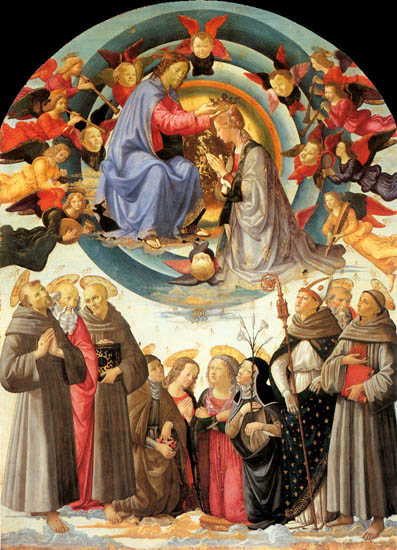
The 'Coronation in Città di Castello' is untypical of Ghirlandaio because of its limited palette: its impact is derived primarily from the contrast of various shades of blue and red with a few yellow highlights. In contrast with the old-fashioned picture in Narni, only the female saints in the centre are kneeling; three holy men are standing on each side of them. This emphasizes the circular glory composed of airy shades of blue, giving the work a dynamic and animated character. The saints on this picture are mainly ones from the Franciscan order. On the far left stands the founder of the order, Saint Francis of Assisi.
This altarpiece is not an autographed work, it was probably made by the workshop.
Madonna and Child Enthroned between Angels and Saints: ca 1486
Galleria degli Uffizi, Florence
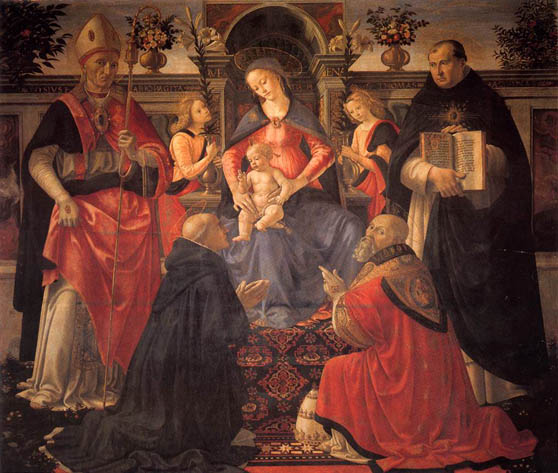
At the front right, Pope Clement is kneeling. He has laid down his papal tiara in front of him and appears to be urging the observer to take part in a humble worship of the Madonna. Saint Dominic, the founder of the order of the Dominicans, is kneeling next to him, and on the right the Church Father Saint Thomas Aquinas is holding out a valuable book.
Adoration of the Magi: 1487
Galleria degli Uffizi, Florence
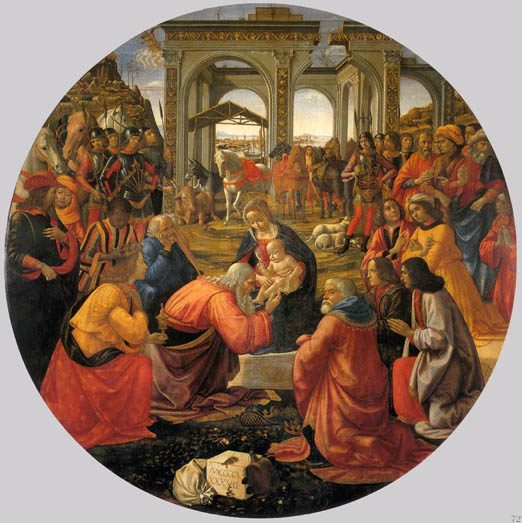
In 1487, Ghirlandaio painted another 'Adoration of the Magi', a large circular painting for the Tornabuoni family. The date is confirmed by Roman numerals: MCCCCLXXXVII.
Such tondos were particularly popular as decorative items in private rooms, and their circular form required a particularly skillful composition. In the centre the childlike Mary is enthroned with her child. In the background, behind the ruined arcades of a classical building, is a simple hut that provides the ox and ass with a stable and the holy family with shelter. The kings' large retinues are lined up right to the ruin, and only behind the Madonna is there a circle of empty space. In other words the composition is influenced by the form of the panel.
On the left is a lovely group of four soldiers with helmets and lances, looking in various directions. The soldiers have four horses that are also looking in different directions. Their pendant on the right, further back, is a group of four other soldiers in magnificent contemporary armor. The horses in front of the ruin are also very successful, and in them Ghirlandaio showed that he was also capable of depicting animals with strong foreshortening and from various angles. The contrast between the magnificent gray stallion and the darker gray ass is surely intentional. Above these animals the observer's gaze wanders through the open arched architecture of the classical ruin out into the far distance. There, painted in an atmospheric paleness, is a city surrounded by water and reminiscent of Venice.
The composition of this Adoration contains allusions to the unique panel created in 1481 by Leonardo da Vinci, now in the Galleria degli Uffizi. Though Leonardo never completed this work, it had an enormous influence on the artists of his age. Ghirlandaio adopted the pyramidal composition of the main figures, with Mary at the top. The circular empty space behind Mary in the tondo might also have been inspired by Leonardo's picture.
A replica of this tondo, in smaller dimensions and entirely the work of Domenico's shop, is to be found in the Galleria Palatina at Palazzo Pitti in Florence.
Portrait of Giovanna Tornabuoni: 1488
Museo Thyssen-Bornemisza, Madrid
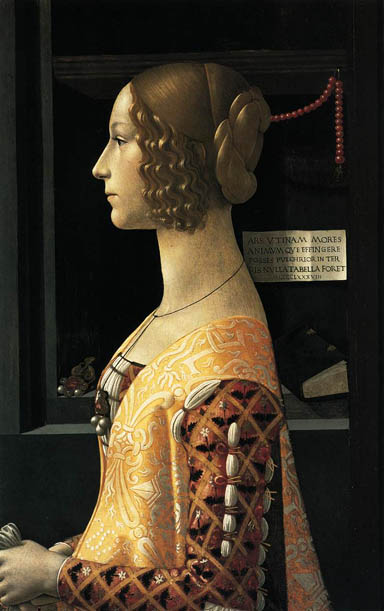
Ghirlandaio incorporated portraits of his contemporaries in many biblical scenes. It is probably for precisely that reason that he was so popular among the rich Florentines, who were particularly keen on self portrayal. This makes it all the more astonishing that so few secular portraits by Ghirlandaio have survived.
There are two paintings dating from about 1490, in the Paris Musée du Louvre and in Madrid, that are masterpieces of his art and yet fundamentally different: Giovanna Tornabuoni is idealized to the extent of becoming an "icon" of beauty for young Florentine girls, while the old man with the boy is painted with a pitiless degree of realism. Ghirlandaio does not shrink even from depicting his nose in all its disfigurement.
The painting in Madrid depicts Giovanna degli Albizzi in a magnificent garment made of gold brocade with tight, slitted silk sleeves. She came from one of the most important Florentine families and in 1486 married Lorenzo Tornabuoni. After her early death Ghirlandaio created two portraits, and it is possible that he was able to produce the cartoon for them while she was still alive.
In a fresco in the Tornabuoni Chapel, Giovanna is depicted as an entire figure witnessing the Visitation. The artist used that portrait in his panel painting with a new background, though he unfortunately cut the arms and hands off rather awkwardly. The delightful young woman now stands out, in a clear contrast of light against dark, from the black niche in the background. The reserved beauty of the young woman is fittingly expressed in the formal clarity of the composition.
She is wearing a valuable piece of jewelry, comprising a ruby in a gold setting with three silky shining pearls, hanging from her neck by a delicate cord. There is a very similar item of jewelry on the shelf behind her, and this, combined with red coral beads against the black background, gives the work a noble elegance. These beads are part of a rosary, and the section that is hanging straight down emphasizes the vertical line of her back, and also directs our gaze to the prayer book. Between these two "pious" objects is a little note alluding to the beautiful soul of the portrayed woman by means of an epigram written by the Roman poet Martial in the first century A.D.:
Ars utinam mores animumque effigere posses pulchrior in terris nulla tabella foret.
(Art, if only you could portray mores and spirit, there would be no more beautiful picture on earth).
This outstanding portrait, one of the most famous of the Quattrocento, makes it clear that portraits of women were one of Ghirlandaio's ideal subjects.
Portrait of a Young Woman
Museu Calouste Gulbenkian, Lisbon

Portait of a Girl
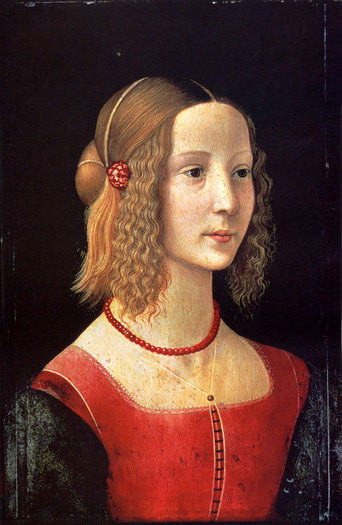
An Old Man and His Grandson: ca 1490
Musée du Louvre, Paris

Ghirlandaio incorporated portraits of his contemporaries in many biblical scenes. It is probably for precisely that reason that he was so popular among the rich Florentines, who were particularly keen on self portrayal. This makes it all the more astonishing that so few secular portraits by Ghirlandaio have survived.
There are two paintings dating from about 1490, in the Paris Musée du Louvre and in Madrid, that are masterpieces of his art and yet fundamentally different: Giovanna Tornabuoni is idealized to the extent of becoming an "icon" of beauty for young Florentine girls, while the old man with the boy is painted with a pitiless degree of realism. Ghirlandaio does not shrink even from depicting his nose in all its disfigurement.
In his double portrait in the Musée du Louvre, the artist succeeds not only in portraying the two figures with great tenderness, but also in conveying the deep affection between them. The boy is gently snuggling up to the old man. Their eyes meet on a diagonal: this balances the composition, and also excludes the observer from the intimate scene. The boy is looking upwards along the old man's outline, which means that he is actually looking directly at the enormous nose projecting towards him. The contrast makes the little boy's snub nose, and the way his mouth is opened in astonishment, appear all the more childlike. The old man is sitting in the corner of a room in front of an open window the delicacy of the beautiful view of the landscape is, so to speak, a commentary on the profound companionability of the two generations. A soft light is falling and the faces through the window, and the old man is lit from the right and the boy from above. As the lit halves of their faces are turned towards each other, and the same bright red is used for the garments and cap, producing a richness that contrasts with the gray wall behind, the two figures seem to merge to form one. The picture is entirely composed with their unity in mind. Flemish influences are unmistakable in both the choice of the corner of the room and the landscape, bringing to mind both Dirck Bouts' 'Portrait of a Man in London' dating from 1462 and several portraits by Petrus Christus.
The identity of the sitters is no longer known, it cannot be stated with certainty whether they are indeed, as is supposed, grandfather and grandson. The man's nose, disfigured by a skin disease called rhinophyma, has in recent years led to the writing of several medical essays. Scratches in the paint layer disfigured it even further. This damage was removed by restoration work carried out in 1996.
Visitation: ca 1491
Musée du Louvre, Paris

The Musée du Louvre in Paris owns a panel painting by Ghirlandaio which differs from others. Like one of the frescoes in the Tornabuoni Chapel, it depicts the Visitation. Ghirlandaio painted the work in 1491 for a private chapel the Tournabuoni owned in the church of Santa Maria Maddalena dei Pazzi. Studies of the garments show how carefully Ghirlandaio prepared each individual figure for this unusual work. That is particularly true of the figure of Saint Mary Salome who is walking in from the right with her hands folded in prayer; wearing a classical flowing garment, she is reminiscent of figures by Filippino Lippi. On the opposite side Saint Mary Jacobi is adopting a most traditional pose, but unusually is looking out of the picture to the left. These two figures at the sides are cut off by the edge of the picture, and this brings a more animated note to the peaceful group of the two main figures. Particularly charming is the contrast between the youthful face of Mary and the old face of Elizabeth.
Christ in Heaven with Four Saints and a Donor: ca 1492
Pinacoteca Comunale, Volterra

The compositional scheme of a central figure surrounded by saints is used by Ghirlandaio in a work dating from about 1492: he depicts Christ, with his hand raised in blessing, enthroned on a cloud bank and surrounded by angels. The main lines of the garments, the contours of the figures, and their gazes all lead the eye to Christ, who crowns the composition of the picture. In the bottom right hand corner kneels the donor Fra Giusto Bonvicini, the abbot of a Camaldolese monastery. He is wearing the habit of the order of the so-called "white Benedictines", an order of hermits founded by Saint Romuald. Ghirlandaio structured this composition in an unusual manner, for the figures appear to be circling an empty central space. Here, however, we can see one of the most successful landscapes Ghirlandaio ever painted.
The bald-headed donor with the striking profile humbly takes his place among the saints worshipping Christ. These are arranged in a rigid symmetry. Two local female saints in shining red are kneeling, seen from behind, in the foreground. The two male saints, similar to the point of confusion, are standing like columns on either side.
The altarpiece was painted for the Camaldolite abbot Buonvicini of the Badia di San Giusto, outside Volterra, and now it is in the Civic Picture Gallery of that town.
The Nativity: ca 1492
Pinacoteca, Vatican

This painting depicts the Nativity according to the archaizing schemes of late-quattrocento Florentine art. The drastic compositional simplification and the reinstatement of the gold ground are indicative of a conservative tendency in Florentine religious painting of this period.
Formerly the painting was attributed to Bastiano Mainardi. The contribution of Ghirlandaio's workshop is assumed.
Madonna in Glory with Saints: 1490-96
Alte Pinakothek, Munich

Ghirlandaio's greatest achievement was the decoration of mainly private chapels with monumental frescoes. The furnishings of a chapel also included an altarpiece, and normally this would consist of an altar painting. The altarpieces normally found in Gothic art, consisting of several individual panels, with images painted on a gold background, had largely disappeared by Ghirlandaio's time. A new type of altarpiece had become common: the square panel.
In the Tornabuoni Chapel of the Santa Maria Novella, Ghirlandaio made sure that the painted furnishings were complete. Part of the entire extent of the Tornabuoni commission included a panel painting for the main altar in the church of Santa Maria Novella - the Pala Tornabuoni - and its rear panel facing the apsidal chapel. The ensemble was dismembered in 1816, the main altar painting, which depicts the most important saints for this place, is now on show in Munich. From the six wings of the front side - mentioned by Vasari - supposedly two are in Munich, one in Budapest and one in Paris. The rear panel, the 'Resurrection of Christ' is now in Berlin. Both works were begun during the last years of Ghirlandaio's life and were probably not completed until after he had died. There has been much debate as to which parts were painted by Ghirlandaio himself, and which by his workshop.
In the central panel of the Pala Tornabuoni, shown here, Mary, the main patron saint of the church, is floating in glory with her child, surrounded by angels and above Saint Dominic, to whose order the monks of Santa Maria Novella belonged. Holding a book, Sain Dominic is kneeling in front of Archangel Michael. On the right, Saint John the Baptist is standing in front of the kneeling Saint John the Evangelist. The cycle of frescoes on the right wall of the chapel deals with the Baptist in more detail.
Saint Catherine of Siena and Saint Lawrence: 1490-98
Alte Pinakothek, Munich
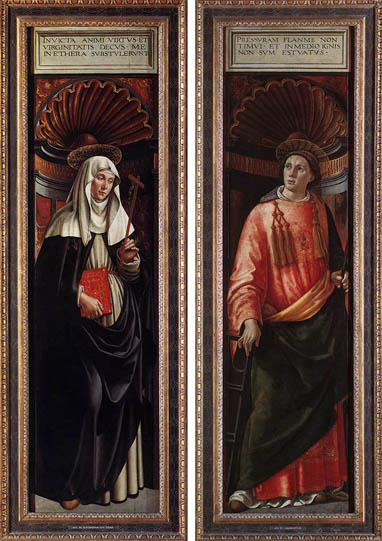
The picture shows two wings of the Pala Tornabuoni executed by Ghirlandaio's workshop and probably finished after the death of Ghirlandaio.
Saint Stephen: 1490-94
Museum of Fine Arts, Budapest

Vasari wrote with admiration about the high altar of Santa Maria Novella in Florence, Ghirlandaio's last work, which was finished by his pupils. Until 1804 it stood in its original place, and then was dismembered and scattered in various collections all over Europe. The central piece depicting the Madonna and saints in a ring of cherubs, together with the wings portraying Saint Catherine and Saint Lawrence, is now in the Alte Pinakothek in Munich, the Resurrection, which was, according to Vasari, originally on the back of the central panel and was completed by Ghirlandaio's brothers Benedetto and Divide, found its way from Florence to the Berlin-Dahlem Museum. The wings representing St Vincent and St Anthony were also in the Berlin-Dahlem Museum, but they were destroyed in 1945, during the war.
Today we cannot exactly reconstruct the original form of the altar. Traditionally all the panels in Berlin are regarded as having belonged to the back of the altar, but while Vasari mentions six wings describing the front of altarpiece, he does not mention such on the back. Thus the supposition that the saints in Munich and Berlin, together with the Saint Stephen in Budapest and with St Peter the Martyr, earlier in a private collection in Paris, all decorated the front of the altar seems justified.
The painting was executed by Ghirlandaio and his workshop.
Adoration of the Child
Pinacoteca Ambrosiana, Milan
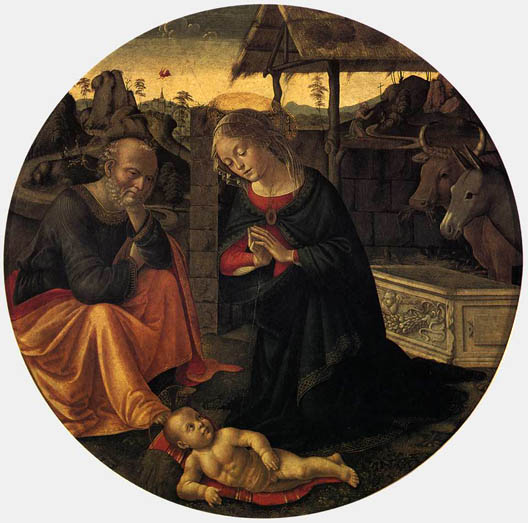
This tondo was attributed to Domenico Ghirlandaio or his workshop, as some details in it are derived from his successful 'Adoration of the Shepherds' in the Sassetti Chapel. The Madonna, for example, is a mirror image. The ox and ass, together with their marble crib, have been moved to the edge of the picture. Joseph and the Christ Child at the front edge of the picture are adapted to the shape of the frame. The child's unusual posture is reminiscent of classical depictions of river gods.
It is likely that Ghirlandaio's workshop produced an entire series of such paintings, only a few of which have survived.
Annunciation: 1489-90
Porta della Mandorla, Duomo, Florence
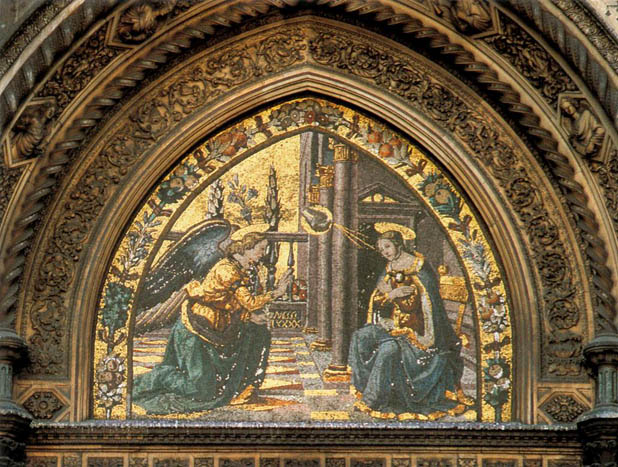
In addition to the fresco in the Tornabuoni Chapel, Ghirlandaio created another 'Annunciation' between 1489 and 1490 using the ancient mosaic technique, which he had learnt from Alessio Baldovinetti and which he had been able to employ when restoring a few old mosaics. There is no lectern in this mosaic version of the 'Annunciation', though the influence of Leonardo's painting is still felt, particularly in the spatial arrangement - a building on the left behind Mary and a view over a wall to a landscape.
Above the Porta della Mandorla on Florence Cathedral there still exists this mosaic. Vasari wrote the following comment on it: "Domenico enriched the modern art of working in mosaic infinitely more than any other Tuscan, as his works, though few, amply demonstrate".
Of this mosaic destined for the Porta della Mandorla Domenico only executed the cartoon, which was probably translated into mosaic by his brother David.
Nativity: ca 1492
Fitzwilliam Museum, Cambridge
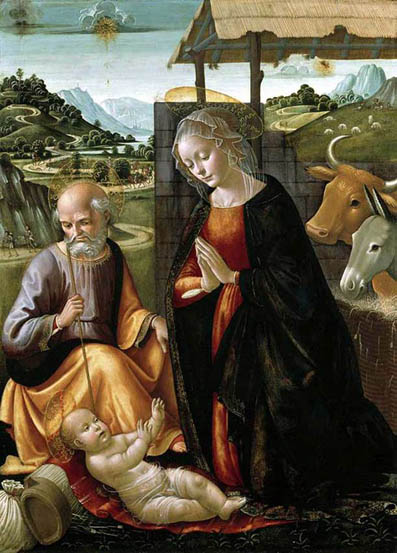
Adoration of the Magi for the Spedale degli Innocenti: 1488
Given his large-scale projects, Ghirlandaio could scarcely be expected to carry out such altar paintings in person. This was also realized by his donors, for some of them wrote into the contracts that the works they were paying for had to be painted by him in person. For example, on 28 October 1485, the Francesco di Giovanni Tesori, the prior of an orphanage ordered a panel painting of the Adoration of the Magi from Ghirlandaio. The picture was intended for the main altar of the Spedale degli Innocenti, a foundling hospital. Fra Bernardo acted as the middleman and drew up a contract which made the following requirements: Ghirlandaio had to "color the aforementioned panel himself, in the manner that can be seen on a paper drawing, with the figures and in the manner as depicted there, and in all details in accordance with what I, Fra Bernardo, consider to be best: he must not deviate from the manner and composition of the mentioned drawing." In addition, the artist had to color the panel at his own expense and use good quality paints. Even the quality of the particularly expensive blue color was precisely laid down in the contract: the artist had to use "ultramarine costing 4 florins per ounce". Ghirlandaio had to deliver the panel paintings after thirty months and would receive 115 large florins for it if the panel turned out to be worth the sum. The decision in that respect was in the hands of the contract's middleman, and as he assured himself in the text: "I can obtain an opinion as to its value or artistic merit from whomever I please, and if it does not appear to be worth the fixed price, he (Ghirlandaio) will receive as much less as I, Fra Bernardo, consider to be appropriate." Completed in 1488, the work, which delighted the middleman and client, is one of Ghirlandaio's finest panel paintings. The artist received the agreed fee, together with additional funds for a predella with stories of the Virgin. The scenes of the predella are the work of one of Ghirlandaio's pupils, Bartolommeo di Giovanni as confirmed by the records. The great cornice of the altarpiece had been executed by the carpenter Francesco Bartolo on designs by Giuliano da Sangallo.
The painting remained over the altar until 1786, when the inside of the church was restored and the altarpiece placed in the wall behind the altar. In 1917 it was transferred to the Hospital's museum.
Adoration of the Magi: 1488
Spedale degli Innocenti, Florence
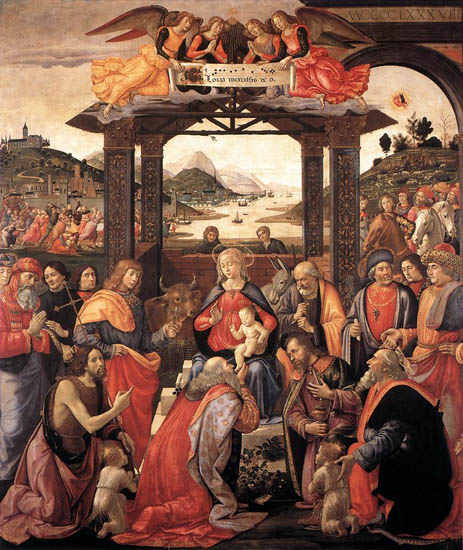
Vasari writes about the painting: "In the church of the Innocenti he painted in tempera a much-admired picture of the Magi, containing some fine heads and varied physiognomies of people both young and old, notably a head of the Virgin, displaying all the modesty, beauty and grace which art can impart to the Mother of God".
There are so many Saints in this Adoration that it is not easy to make out the three Magi. On the left, Saint John the Baptist is kneeling and pointing to the Madonna. The orphans of the Spedale are represented by two of the innocent boys who were killed during the 'Slaughter of the Innocents' in Bethlehem, kneeling in the foreground. There are gaping bloody wounds to their faces, arms and necks.
In this 'Adoration of the Magi', Ghirlandaio's carefully thought out use of color is particularly impressive: Ghirlandaio distributes the glowing colors evenly. Mary in the centre is wearing a blue cloak over a red dress. The oldest king kneeling in front of her is wearing a variation of these colors combined with yellow. To the left of Mary, the youngest king holding the valuable goblet in his hand - he almost looks like Saint John the Evangelist - is also dressed in blue, yellow and red. The figure standing on the right edge of the picture wearing an expensive hat repeats this combination of colors, though now the blue and yellow are reversed. In the second figure from the right, wearing the blue hat, the Madonna's colors of red and blue are visible again, and they are repeated in clothes of the bearded man wearing a turban on the left edge of the picture. Between the Madonna and the man with the blue hat on the right, the artist creates a yellow highlight, though with a weaker blue accent, in the figure of Joseph. This row of figures alone produces a rhythm of color from left to right: red and blue; yellow, blue and red; red and blue; yellow and blue; red and blue; yellow, blue and red.
The work represents one of Ghirlandaio's most important "easel" works. Here too the assistants were at work. Indeed, in the scene of the 'Slaughter of the Innocents' in the background, Berenson recognized the hand of Bartolomeo di Giovanni, the author of the stories from the predella.
Source: Web Gallery of Art
Return to Pagina Artis
Return to Bruce and Bobbie's Main Page.